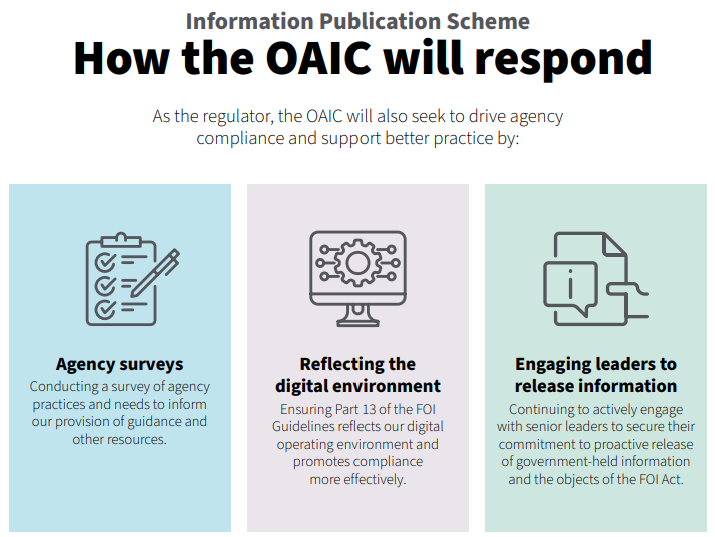-
On this page
Published date: 12 June 2024
Download the Information Publication Scheme – Review 2023
1 Foreword
The Information Publication Scheme (IPS) requires agencies to publish a broad range of information on their website and to proactively publish other information. The IPS continues to be an important element in ensuring information held by Australian Government agencies is managed for public purposes and is treated as a national resource.
Compliance with the IPS is an ongoing statutory responsibility for agencies subject to the Freedom of Information Act 1982 (FOI Act). Agencies must publish an IPS Plan, select information for publication, ensure that information is accessible and useable by the community, establish internal governance arrangements to support the IPS, align the agency’s information assets with IPS objectives and regularly review the agency’s performance.
The results of the survey help both the OAIC and agencies identify areas where improvements can be made to support the proactive publication of information held by Australian Government agencies, and inform the OAIC’s regulatory priorities.
This is the third survey by the Office of the Australian Information Commissioner (OAIC) into agencies’ compliance with IPS obligations. We now have results from 2012 and 2018 to provide sound comparative data.
A total of 196 agencies participated in the survey out of 209 agencies that were invited to take part, representing a strong response rate of 94%, and above the 2018 response rate of 82%.
The results showed continued commitment across government to the IPS. Pleasingly, the results provide strong evidence of an increasing focus on accessibility.
However overall, the results provide persuasive evidence that there is much to be done to realise the object of the FOI Act that information held by Government is to be managed for public purposes, and is a national resource.[1]
Agencies identified significant challenges to publishing public sector information including:
- information asset management
- discoverable and useable information
- effective information governance, and
- identifying the best ways to engage the community.
It was also notable how results differed between larger and smaller agencies, and the challenges for smaller agencies in developing the policies and frameworks to publish IPS documents.
One finding of concern is that the majority (78%) of agencies believed there would be no change to the number of FOI requests their agencies receive if proactive publication under the IPS was increased. This result requires a rigorous regulatory response as proactive release should be a key tool in creating a better functioning system. The OAIC has actively promoted proactive release and developed tools to support this requirement under the FOI Act. Importantly we have highlighted the value and purpose of proactive release with guidance for senior executives in 2020.
Additionally, guidance in the form of a Statement of Principles to support proactive disclosure of government-held information developed by all Australian information commissioners and ombudsmen was released in 2021. Significantly the lowest scores identified in the survey were in the areas of governance and administration and an open government culture. It was also concerning that only 39% of agencies had updated their Agency IPS Plan within the last year, and that the practice of updating agency IPS plans was inconsistent. Likewise, agencies overwhelmingly responded that they did not change the information they provide under the IPS.
These results indicate that a well demonstrated and consistent commitment to the principles of proactive release and the objects of the FOI Act is required. Accordingly, the OAIC will actively engage with senior leaders to secure their commitment to this important and mandated responsibility. Appointing information access champions may be one way to meet that much-needed visible commitment. The FOI Guidelines highlight the benefits of appointing an information access champion.[2]
It is clear that the involvement of senior leaders in agencies is critical in harnessing the IPS to enable a proactive approach to releasing information.
The OAIC will also seek to drive agency compliance and support better practice, taking into account changes in the operating environment, by conducting a survey of agency practices and needs to inform our provision of guidance and other resources. The intelligence gained together with the results of this survey will also inform a review of Part 13 of the FOI Guidelines to ensure it reflects our digital operating environment and more effectively promotes compliance. Through this approach we will support agencies to effect better outcomes consistent with the objectives of the IPS, and embed a culture of compliance in a systematic and rigorous manner.
The OAIC looks forward to working together with agencies as we continue to promote a proactive approach to publishing government information by further strengthening the IPS.
Elizabeth Tydd
Freedom of Information Commissioner
22 May 2024
2 Executive summary
2.1 Background
In July 2023, ORIMA Research was commissioned by the Office of the Australian Information Commissioner (OAIC) to conduct a survey of those Australian Government agencies subject to the FOI Act, and their compliance with the Information Publication Scheme (IPS) under the Freedom of Information Act 1982 (FOI Act). A total of 196 agencies participated in the survey out of 209 agencies invited to take part, representing a strong response rate of 94%.
In June 2012, the OAIC conducted the first survey of agencies’ compliance with IPS obligations, and management and publication of public sector information by agencies. A subsequent survey was conducted in April 2018.[3] This 2023 IPS survey aligns with the 2012 and 2018 surveys to allow tracking of changes in agency compliance levels over time.
2.2 IPS compliance
Agency IPS operation review
94% of agencies have now completed a review of the operation of the IPS in their agency
Ninety-three per cent of agencies completed the 2023 IPS survey and are now considered to have reviewed the IPS in their agency.[4]
Eighteen per cent of agencies had also completed an independent agency review of the operation of the IPS prior to participating in the survey.
Among agencies that completed an IPS Operation Review before the survey, 94% completed this review in the last 24 months and 6% did so more than 2 years ago.[5]
At least 85% of agencies that completed an IPS review before completing the survey covered each of the 5 key elements of IPS compliance as set out in Part 13 of the FOI Guidelines,[6] and:
- almost all agencies reviewed their agency IPS plan (97%), IPS document holdings (91%), and governance and administration (91%)
- 86% indicated that their reviews included coverage of their agency compliance review and structure of the IPS (previously referred to as ‘IPS information architecture’).
Agency IPS plan
90% of agencies have published an Agency IPS plan
The proportion of agencies that published an Agency IPS Plan in 2023 was 90%, compared to 88% in 2018 and 94% in 2012. Reasons provided by agencies for not publishing an IPS plan included that the plan is being reviewed or updated; the plan is currently being developed; and having insufficient resources to do so.
Of those agencies with a published IPS agency plan, 81% used some or all of the standard headings recommended by the OAIC. This is lower than the 89% recorded for the same measure in 2018, and 96% in 2012. The proportion using all 5 standard headings declined from 81% in 2012 and 62% in 2018 to 37% in 2023. Most agencies that do not use the standard headings indicated that they use similar headings and language that reflects the intended content, and which, for some agencies, is considered more user-friendly.
In 2023, coverage of recommended content in IPS agency plans was lower than in 2018 and 2012. Over 60% of agencies indicated that their IPS Agency Plan included 7 of the 9 areas of recommended content outlined in the FOI Guidelines. However, only 26% of agencies indicated that their plan specified whether an internal IPS information register has been developed (down from 37% in 2018 and 54% in 2012). In line with 2018, 22% of agencies specified the measures (if any) being taken to improve the agency's information asset management framework to support its IPS compliance, down from 53% in 2012.
Time since last update of Agency IPS Plan
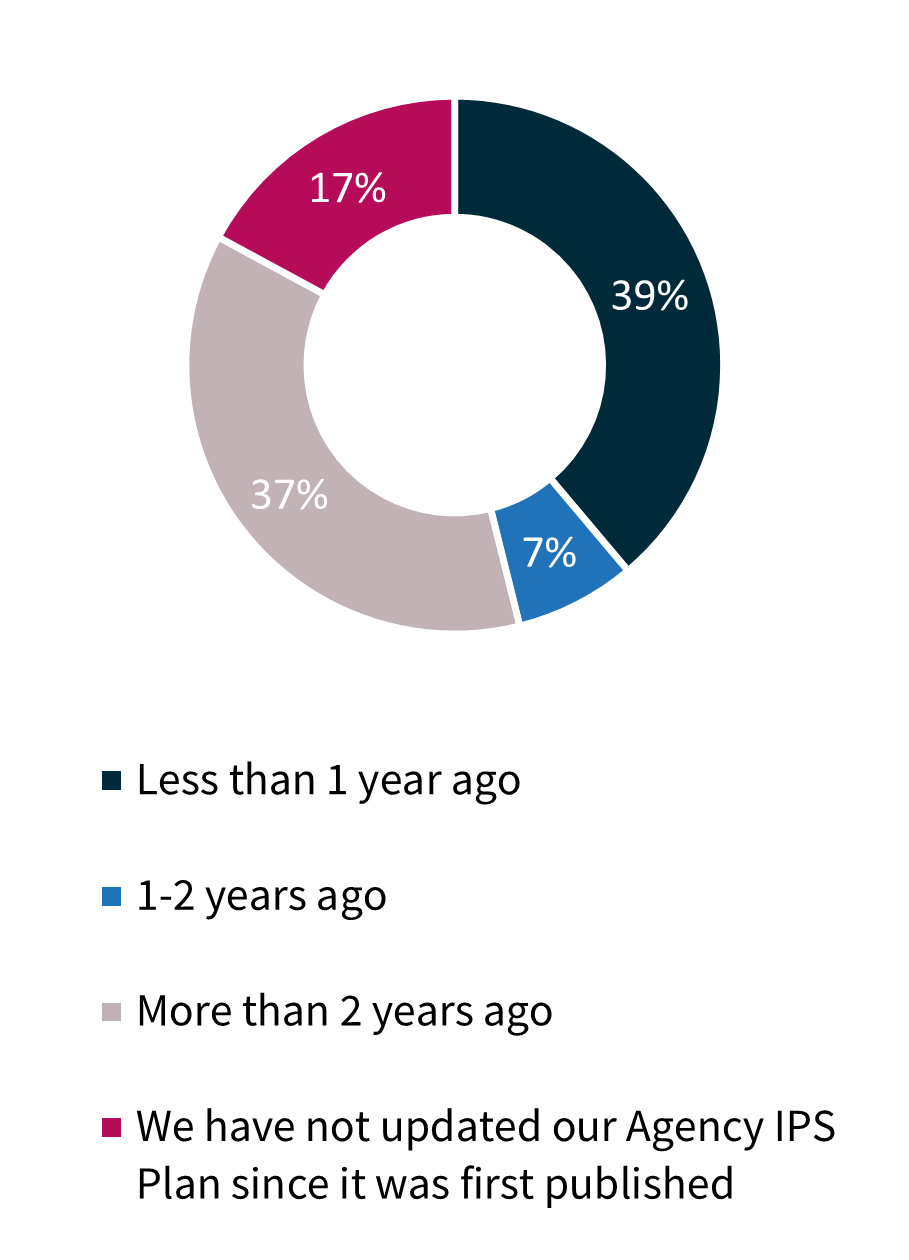
The survey also found that the practice of updating agency IPS plans was inconsistent.
While 39% of agencies had updated their Agency IPS Plan within the last year, 37% had updated their plan more than 2 years ago. Seventeen per cent had not updated their plan since it was first published (which was most commonly over 5 years ago (79%), although 15% were updated within the last twelve months).
Sixty-one per cent of agencies indicated they have a timetable for formally reviewing their Agency IPS Plan – in line with 62% in 2018 but below 84% in 2012. Among agencies that have a timetable, 38% planned to review the plan at least every 12 months, 43% on a regular basis (but less than every 12 months), and 18% only where significant IPS changes occur.
IPS governance and administration
78% of agencies have appointed a senior executive officer to lead the agency's work on IPS compliance
Seventy-eight per cent of agencies indicated they have appointed a senior executive officer to lead the agency’s work on IPS compliance. This result is slightly higher than 76% in 2018, but lower than 93% in 2012.
Among those with a formal IPS governance structure, this was most likely to be some ‘other’ governance structure (60%). These ‘other’ governance structures included committees, boards and groups with broader responsibility than IPS, such as executive leadership and management teams and risk and legal teams. A relatively smaller proportion of agencies identified that their formal IPS governance structure(s) consist of a working group (30%) and/or steering committee (12%).
Fifty-five per cent of agencies have assigned responsibility for the management or coordination of staff training and awareness of IPS obligations – in line with 54% in 2018, but lower than the 73% in 2012. Sixteen per cent of agencies indicated that induction training for new staff includes information on the IPS (in line with 16% in 2018 but below 23% in 2012), while 17% indicated they provide staff with other specific training on IPS obligations, lower than 25% in 2018 and well below 49% in 2012.
55% of agencies have assigned responsibility for the management or coordination of staff training and awareness of IPS obligations
IPS entry
Over 70% of agencies publish each of the required types of information on their website
In 2023, over 70% of agencies indicated they publish each of the required types of information on their website. Information relating to annual reports, the agency’s functions and decision-making powers, contact details for FOI information, organisation structures, and information released in response to FOI access requests via an agency Disclosure Log were most commonly published (by at least 95% of agencies in 2023, broadly similar to 2018 and 2012).
The types of information least likely to be published included:
- consultation arrangements for members of the public to comment on specific policy proposals for which the agency is responsible (75%, slightly above 72% in 2018 but below 86% in 2012)
- information in documents to which agencies routinely give access in response to requests under Part III of the FOI Act – s 8(2)(g) (73%, down from 79% in 2018 and 86% in 2012).
Thirty-four per cent of agencies indicated they have made a decision not to publish information under the IPS due to the personal or business information exception in s 11C of the FOI Act, being lower than the 42% recorded in 2018 and 36% recorded in 2012.
Twenty per cent of agencies indicated they maintain an IPS information register, down from 38% in 2018 and 36% in 2012. Thirty-four per cent of agencies without an IPS information register indicated that they plan to develop one in the next 12 months, also down from 2018 (53%) and 2012 (51%).
A minority of agencies with IPS information registers indicated that they reviewed their registers every 6 months (20%) or every 12 months (28%), with a larger share indicating that they reviewed their registers only when significant IPS changes occur (33%) or that they did not know how often reviews occurred (20%).
More agencies (82%) indicated they do not charge for information required or permitted to be published under the IPS in 2023, up from 73% in 2018 and 68% in 2012.
Structure of the IPS [7]
More than 70% of agencies use 6 out of the 10 recommended standardised headings and structure
Most agencies present their IPS information using the 10 recommended headings specified in the FOI Guidelines.[8] Agencies were most likely to use headings such as ‘Contact us’ (87%) and ‘What we do’ (79%) in 2023. However, less than half of agencies indicated that they presented their information under the headings ‘Our priorities’ (38%, down from 49% in 2018), ‘Our finances’ (33%, down from 46% in 2018) and ‘Our lists’ (25%, down from 39% in 2018).
There was a substantial improvement in the accessibility of IPS documents in 2023. In particular, 82% of agencies indicated that all or most documents they have published under the IPS are in a format (or multiple formats) which conform to Web Content Accessibility Guidelines (WCAG) 2.0 requirements, which is considerably more than the 69% in 2018 and 50% in 2012.[9]
The survey also found considerable variation in the proportion of agencies that provide access to website features that assist in the discoverability and understanding of information published under the IPS.
For example:
- 73% of agencies reported they have a search function that can access information published within an agency’s IPS entry, up from 63% in 2018, but lower than the 81% reported in 2012.
- 14% of agencies indicated that the OAIC IPS icon is visible on the homepage of their website, less than the proportion recorded
2.3 Management and publication of public sector information
Open access to information
29% of agencies have adopted a strategy for increasing open access to public sector information
Twenty-nine per cent of agencies indicated they have adopted a strategy for increasing open access to public sector information held by their agency, in addition to the information required to be published in the IPS and Disclosure Log (down from 35% in 2018, but slightly higher than the 27% reported in 2012). The proportion of agencies indicating that this strategy is under development in 2023 declined from 2018 and 2012 (17%, down from 26 and 48%, respectively). The proportion that indicated that they have not adopted such a strategy has increased (from 39% in 2018 and 25% in 2012, to 54%).
Seventy-three per cent of agencies indicated they use social media sites to publish or promote access to public sector information (including linking to information published on their agency’s website). They were most likely to use LinkedIn (65%), followed by X (formerly known as Twitter, 55%) and Facebook (52%).
Discoverability
In 2023, the majority of agencies (65%) indicated that most or all of the public sector information that they have published was in an open and standards-based format – slightly higher than the proportions recorded in 2018 (60%) and well above 2012 (37%).
In 2023, 53% of agencies indicated they routinely apply metadata to public sector information they publish on the internet (compared to 46% in 2018 and 49% in 2012), and they were most likely to only use an ‘Other’ metadata standard (87%) rather than the Australia New Zealand Land Information Council (ANZLIC) standard (16%) when doing this.
Challenges to publishing public sector information
86% of agencies identified open access to information as one of the most significant challenges faced when publishing public sector information
When agencies were asked to identify the top 6 challenges they face when publishing public sector information, the themes of the most commonly identified challenges were associated with barriers to:
- open access to information (86%) including ensuring compliance with privacy and secrecy requirements, obtaining sufficient budgetary resources, and identifying information that can be published (in addition to the information required to be published in the IPS and Disclosure Log).
- robust information asset management (65%) including establishing and maintenance of an information asset register, and protecting information against inappropriate or unauthorised use, access or disclosure.
- discoverable and useable information (39%) including agency costs (for example, staff time) associated with ensuring compliance with WCAG 2.0.
- effective information governance (38%) including establishing an appropriate focal point, officer, or centralised department that is responsible for furthering open access to public sector information and instigating strategic planning on information resource management.
- engaging the community (29%) including identifying re-users and establishing effective processes to consult the community regarding what information to publish.
3 Introduction
3.1 Background
On 1 May 2011, compliance with the Information Publication Scheme (IPS) was introduced and is an ongoing statutory obligation for agencies subject to the Freedom of Information Act 1982 (FOI Act). Agencies are required to proactively publish a range of documents and information on their websites and are encouraged to publish additional information beyond that required by the FOI Act. The IPS underpins a pro-disclosure culture in government, marked by proactive release and publication of government information.
Part 13 of the Guidelines issued by the Australian Information Commissioner under s 93A of the FOI Act (FOI Guidelines) to which agencies must have regard in performing a function or exercising a power under the FOI Act, provides agencies with guidance for conducting a review of agency IPS compliance. The FOI Guidelines note that agencies should focus on 5 key elements of IPS compliance when undertaking a review of the IPS. The 5 key elements are:
- Agency plan – has the agency published a comprehensive plan for its IPS compliance?
- Governance and administration – does the agency have appropriate governance mechanisms in place to meet its IPS obligations, including an information management framework?
- IPS document holdings – has the agency reviewed its document holdings to decide what information must be published under s 8(2) and further information that can be published under s 8(4)? Is the agency IPS entry accurate, up-to-date and complete?
- Structure of the IPS (formerly referred to as information architecture) – does the agency have a publication framework in place and has it taken the necessary steps to ensure information in its IPS entry is easily discoverable and accessible to the Australian community?
- Agency compliance review – does the agency have appropriate processes, systems and resources in place to monitor and review its IPS compliance and to make necessary improvement in the agency's IPS implementation?
In June 2012, the Office of the Australian Information Commissioner (OAIC) conducted the first survey of Australian Government agencies’ compliance with IPS obligations. Part A of the survey assessed compliance with the 4 key IPS criteria set out in the FOI Guidelines.
The 2012 survey was undertaken by ORIMA Research on behalf of the OAIC. The survey found agencies displayed a high level of compliance with many aspects of the IPS, including almost all agencies publishing an IPS plan, publishing required information on their websites and assigning responsibility for the IPS to a senior officer within their agency.[10] The results of the 2012 survey confirmed a strong commitment across government to compliance with IPS requirements and principles. However, the survey also identified areas where improvement was required, such as IPS governance and administration and structure of the IPS.
The 2012 IPS survey was conducted in conjunction with a survey of the management and publication of public sector information. Part B of the survey sought general information about the management of public sector information by agencies and the publication of other public sector information under s 8(4) of the FOI Act. The responses to the survey helped to build a picture of the types of public sector information which is held and published in a way which facilitates reuse by the community. The survey also helped to identify areas in which agencies could benefit from assistance or further guidance. The survey results were published in February 2013.[11]
In 2012, the OAIC planned to undertake a further survey of Australian Government agencies in 2014. However, around the time the second survey was to be undertaken, the Government announced plans to disband the OAIC by the end of 2014, with policy responsibilities to be undertaken by the Attorney-General’s Department, including the Information Publication Scheme. As a result, the OAIC was unable to undertake a second survey in 2014. However, the OAIC was not disbanded in 2014 and FOI functions were confirmed as remaining with the OAIC in July 2016. In January 2018, the OAIC undertook to conduct the second survey during 2018.
In early 2018, the OAIC commissioned ORIMA Research to conduct the second survey of Australian Government agencies’ compliance with their IPS obligations. The survey assessed compliance with the 5 key IPS elements, as set out in the FOI Guidelines.[12]
The focus of the 2018 survey was similar to the 2012 survey to facilitate a comparison of results between the 2 surveys and to allow tracking of changes in agency compliance levels over time.
The 2018 survey also included several new topics and questions, including an additional section to measure the extent to which agencies had complied with their obligation under s 9 of the FOI Act to conduct a review of the operation of the IPS within their agencies by 1 May 2016.[13] The survey also included questions about the management and publication of public sector information.
In July 2023, the OAIC commissioned ORIMA Research to conduct the third cycle of this survey. The 2023 survey retained similar questions and topics to previous surveys to facilitate a comparison of results and allow tracking of changes in agency compliance levels over time. This survey contained several new questions, such as:
- questions about agency arrangements (including staff resources), used to manage the IPS
- feedback gathered about the IPS
- agency review of recent changes to Part 13 of the FOI Guidelines
- perceived impacts of proactive publication of information under the IPS on the number of FOI requests
- approaches to releasing routinely requested statistics and
- guidance provided to staff about how to identify ‘other’ information which can be published under the IPS.
In line with the approach taken in the 2018 survey, the OAIC considered submission of the 2023 IPS survey to have satisfied an agency’s requirement to conduct a review of the operation of the IPS in their agency in conjunction with the Information Commissioner.
This report presents the results from the 2023 IPS agency survey, which was conducted between September and October 2023.
3.2 Research objectives
The results of the research have been used by the OAIC to develop this report about IPS compliance across all Australian Government agencies subject to the FOI Act. The research was also designed to provide:
- a review of the operation of the IPS within Australian Government agencies
- information and feedback about the administration of agencies’ IPS obligations under the FOI Act
- an indication of areas where the OAIC can provide assistance or further guidance to agencies
- an assessment of agencies’ compliance with their IPS obligations
- a comparative analysis against agency compliance reported in August 2012 and August 2018
- information on the direction of the OAIC’s work in policy, compliance and communications as the national FOI regulator
- an opportunity to promote a pro-disclosure culture in government.
3.3 Methodology
The 2023 IPS Survey of Australian Government Agencies was conducted online as a census of all agencies subject to the FOI Act.[14] The methodology adopted in 2023 was consistent with the approach used in the 2012 and 2018 surveys.
The survey fieldwork was conducted between 20 September and 18 October 2023. Fieldwork was extended to 25 October 2023, to give agencies more time to approve their responses through the appropriate clearance channels. Five agencies were provided a further extension until 27 October 2023 to clarify and finalise their responses. Fieldwork was extended to boost the overall response rate, ensuring agencies of all sizes were represented in the final survey data.
A total of 209 agencies were invited to complete the survey, of which 196 responded, representing a strong response rate of 94%.
Before the fieldwork commenced, the Australian Information Commissioner wrote to all agency heads to inform them of the upcoming survey and that ORIMA had been engaged to conduct the survey on behalf of the OAIC.
At the start of the fieldwork period, all invited agencies were sent an invitation email and a unique link to access the survey online. On 21 September 2023, the OAIC and ORIMA held one of 2 information workshops with agencies to explain the importance of the survey, how to access and navigate the online survey tool, and to confirm that invitations had been received. The second workshop was held on 12 October.
The survey data was reviewed and underwent a validation process, involving follow-up emails and telephone calls to selected agencies to verify their responses and, in some cases, to verify that their responses were ready for submission.
3.4 IPS risk mitigation index
The report presents the results of an IPS risk mitigation index to provide a high-level summary of the survey results overall and against 5 compliance criteria (key elements) set out in the FOI Guidelines. The methodology used to calculate the index is consistent with the approach employed in 2012 and 2018. The index does, however, show some compositional differences from these surveys associated with changes to questions across the 3 surveys. The most significant change was due to the inclusion of an additional compliance criterion (Agency IPS Operation Review) in 2018. In 2023, the index accommodated the inclusion of 17 new questions and the removal of one question.
The risk mitigation index provides an index score from 0 to 100 that represents the extent to which agencies comply with the relevant IPS aspects measured in the survey. Higher index scores represent a greater level of compliance (or greater risk mitigation) and therefore more positive results.
Nearly all questions included in the risk mitigation index are yes/no questions where agencies receive 2 points if they provide a yes response (indicating that they comply with the relevant IPS requirement) and zero if they do not comply. An index score is calculated for each agency based on the number of points recorded divided by the number of possible points, multiplied by 100. An index score of 100 would therefore represent an agency complying with each of the aspects included in the risk index, while a score of zero would represent compliance with no aspects.
Index scores between 0 and 100 can be interpreted[15] as representing the average level of compliance amongst agencies with the measures included in the index (for example an index score of 50 can be interpreted as approximately half of agencies complying with the range of measures included in the risk mitigation index).
Six risk mitigation indices are presented in this report, one overall risk mitigation index and 5 risk mitigation indices for each of the key assessment criteria. The overall IPS index is a weighted average of the 5 criteria risk mitigation indices as outlined in Table 1 below. Weights for each criterion were determined by the OAIC based on an assessment of the relative importance of each of the criteria in the overall IPS. They are consistent with those established in 2018 and maintain the relativities between the 4 component indices measured in 2012.
Criteria | Weight in overall index |
|---|---|
Agency IPS Operation Review | 28.6 |
Agency IPS Plan | 10.7 |
IPS Governance and Administration | 21.4 |
IPS Entry | 28.6 |
Structure of the IPS | 10.7 |
3.5 Profile of respondents
The OAIC notified ORIMA Research that some agencies were responding to the survey on behalf of smaller agencies within their portfolio. This has been reflected in the data, with each of these smaller agencies treated as a separate response to the survey. In these cases, the smaller agency responses were identical to the larger agency responses, as the ‘parent agency’ is responsible for the management and implementation of IPS obligations.
As shown in Table 2, 196 agency responses were included in the final survey data, of which 188 were ‘unique’ responses and 8 were duplicated from parent agencies. This approach was also followed in the 2018 survey, where 190 responses were collected (175 ‘unique’ and 15 duplications from ‘parent agencies’) and the 2012 survey (140 ‘unique’ responses and 51 duplicated). The reduction in duplication of responses in both 2023 and 2018 reflects several parent agencies indicating that they no longer manage the IPS on behalf of other agencies in their portfolio. The other agencies identified were often ‘micro’ or ‘extra small’ agencies.
Table 2: Profile of agencies that responded to Information Publication Scheme: Survey of Australian Government Agencies
| 2023 number of agencies | 2023% of sample | 2018 number of agencies | 2018% of sample | 2012 number of agencies | 2012% of sample |
|---|---|---|---|---|---|---|
Agency Size |
|
|
|
|
|
|
Micro agency (less than 20 staff) | 26 | 13% | 28 | 15% | 21 | 11% |
Extra small agency (20 – 100 staff) | 37 | 19% | 44 | 23% | 30 | 16% |
Small agency (101 – 250 staff) | 42 | 22% | 30 | 16% | 25 | 13% |
Medium agency (251 – 1,000 staff) | 37 | 19% | 37 | 19% | 33 | 17% |
Large agency (1,001 – 10,000 staff) | 47 | 24% | 31 | 16% | 24 | 13% |
Extra large agency (more than 10,000 staff) | 5 | 3% | 5 | 3% | 4 | 2% |
Not answered (includes ‘duplicate’ agencies where the agency size data was not duplicated from the parent agency’s response) | 2 | 1% | 15 | 8% | 54 | 28% |
Total | 196 | 190 | 191 | |||
Number of FOI requests | ||||||
None (0 requests) | 39 | 20% | 45 | 24% | 80 | 41% |
Low (1 – 10 requests) | 69 | 35% | 52 | 27% | 39 | 20% |
Medium (11 – 100 requests) | 56 | 29% | 49 | 26% | 43 | 23% |
High (101 – 500 requests) | 21 | 11% | 20 | 11% | 11 | 6% |
Very high (more than 500 requests) | 10 | 5% | 9 | 5% | 3 | 2% |
Not answered (includes ‘duplicate’ agencies where the number of FOI requests data was not duplicated from the parent agency’s response)[16] | 1 | 1% | 15 | 8% | 14 | 7% |
Total | 196 | 190 | 191 |
3.6 Presentation of results
In 2023, the online survey provided to agencies was programmed to ensure that agencies could only submit their survey response if all mandatory questions were answered. Only agencies that completed the submission process have been included in this report (that is, agencies that did not formally submit their responses or provided an incomplete response have been excluded).
Consistent with 2012 and 2018, several agencies’ responses were covered by ‘parent’ agencies. In these cases, the response from the ‘parent’ agency was duplicated in the survey dataset and included as part of the results in this report.
Percentages shown in this report are based on the total number of respondents to the survey (n=196), except where the question did not apply to them (that is, a response to one question sequenced them past a question further along the survey – see Appendix A: Questionnaire for a full representation of these ‘skips’). In these cases, the percentages in the report are based on the number of respondents where the question applied to them.
Percentage results throughout the report may not add up to 100% due to rounding, or where questions allow for respondents to provide more than one answer.
3.7 Quality standards
This project was conducted in accordance with the international quality standard ISO 20252 and ISO27001 accreditation, and the Australian Privacy Principles contained in the Privacy Act 1988.
4 IPS compliance
4.1 Agency operation review[17]
IPS operation overview
94% of (in-scope[18]) agencies completed the 2023 IPS survey
18% of responding agencies completed a review of the operation of the IPS prior to completing the 2023 IPS survey
Ninety-four per cent of agencies completed the 2023 IPS Survey (and have now therefore reviewed the IPS in their agency),[19] while only 18% of agencies had completed a review prior to completing the survey.
Among agencies that completed a review before the survey, a large majority (86%) completed this review within the last 12 months, compared with less than half (44%) in 2018 (see Figure 1). The remaining agencies completed their review 1–2 years ago (9%) or more than 2 years ago (6%).
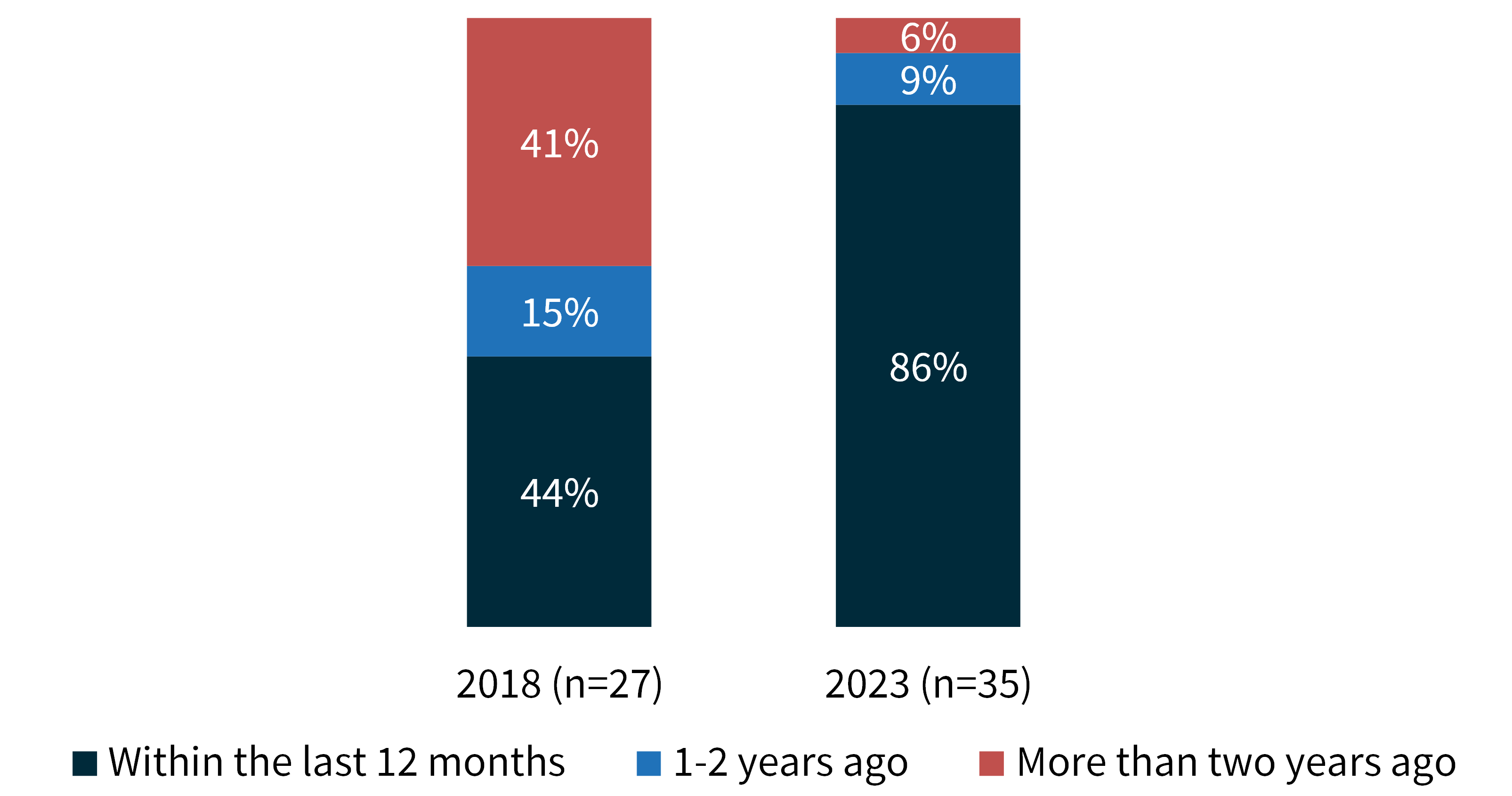
Further analysis by agency characteristics
The extent to which agencies completed a review of the operation of the IPS did not vary significantly by agency size or the number of FOI requests received.
5 key elements of IPS compliance
As shown in Figure 2, at least 86% of agencies that completed a review of the operation of their IPS covered the 5 key elements of IPS compliance as set out in Part 13 of the Freedom of Information (FOI) Guidelines:
- almost all agencies reviewed their agency plan (97%), IPS document holdings (91%), and governance and administration (91%)
- just under 90% indicated that this review included coverage of the structure of the IPS (86%, down from 96% in 2018) and agency compliance (86%, down from 93% in 2018).
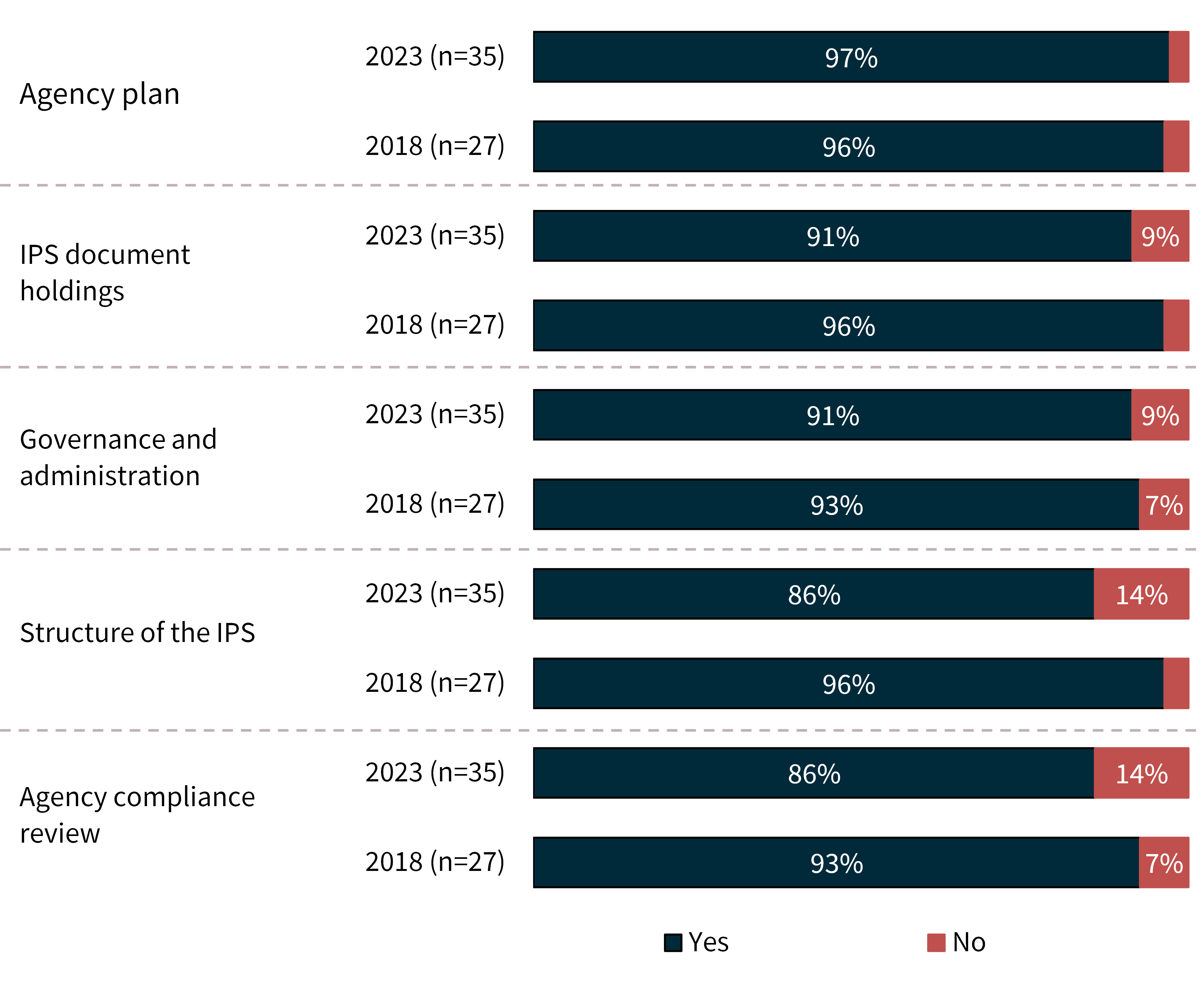
Agencies that completed a review of the operation of the IPS in their agency were asked to briefly describe the outcomes of this review. Similar to 2018, the key outcomes identified by agencies included:
- they were generally compliant with the expectations of the operation of the IPS in their agencies:
‘Governance mechanisms and processes found to be well established and embedded within the agency to continue to meet IPS obligations … Agency IPS plan found to be comprehensive.’
‘The [Agency Name] was compliant with IPS requirements.’ - agency websites have been updated with regard to layout and content:
‘This review resulted in the approval of an updated Agency Plan, Operational Information and associated changes to web site content and layout.’
‘The [Agency Name] updated its IPS Plan and relevant website text to reflect current processes and organisational structure.’ - specific actions needed to be taken to ensure compliance:
‘A publication framework may be required following consultation with agency FOI team. ’
‘The review has identified gaps in the IPS … The agency will work to implement policies, a register and staff training.’
Complaint handling and feedback
67% of agencies’ websites provide information about how to make an IPS complaint
57% of agencies have methods in place for collecting feedback about their IPS practices
Figure 3 shows that 67% of agencies’ websites provided information about how to complain about an agency’s IPS entry. The majority (87%) of agencies did not receive any complaints specifically related to the IPS in 2022–23 (see Figure 3).
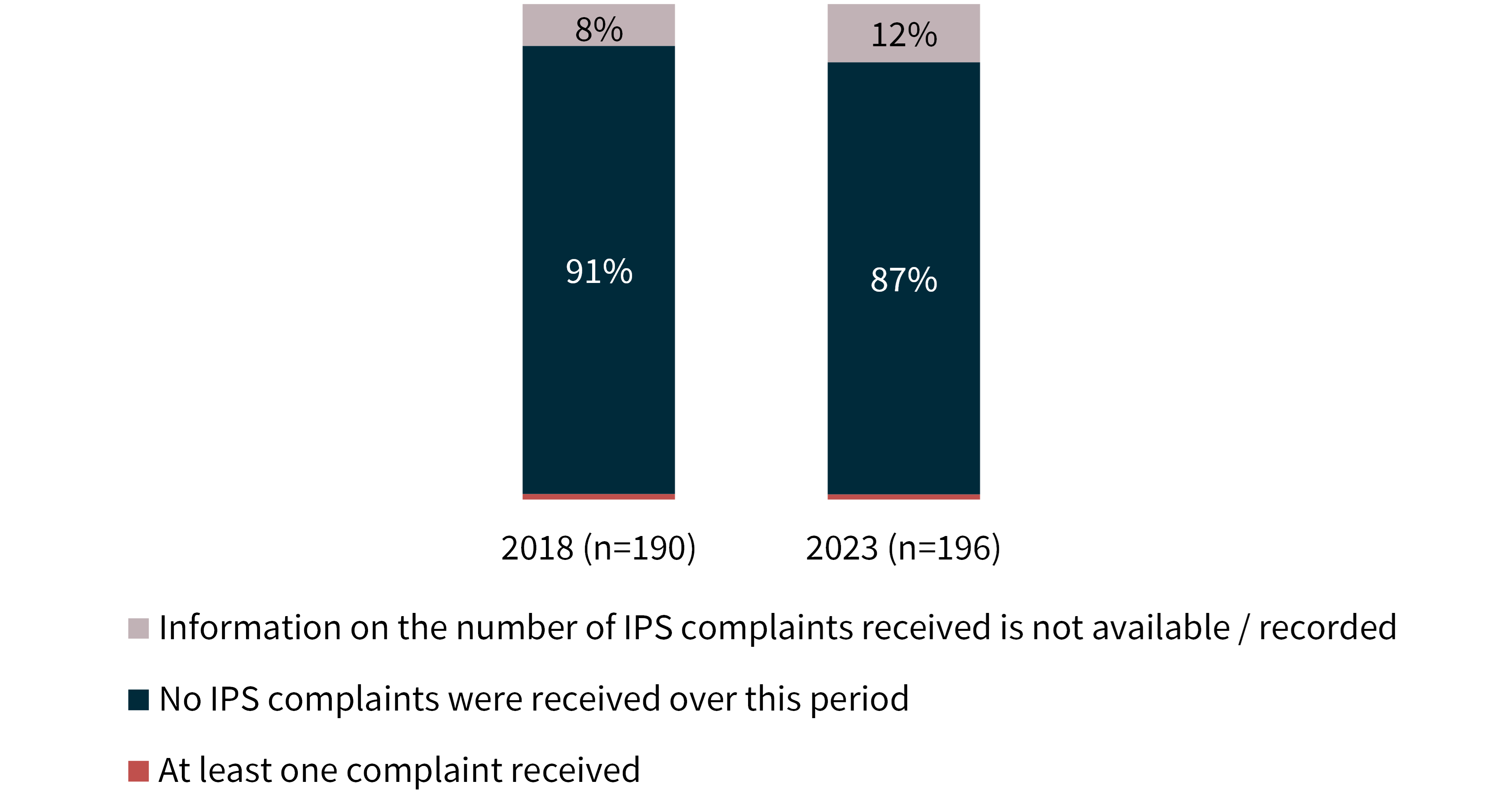
Further analysis of complaints handling by agency characteristics
Micro agencies were the least likely to indicate that their website provides information about how to make an IPS complaint about their agency’s IPS (54%, compared with 60–83% for other agency sizes).
Over half of agencies (57%) reported having methods in place for collecting feedback about their IPS practices. Of these agencies, 58% used a survey, feedback form, or feedback widget hosted on their agency website and 41% used another method of feedback collection (Figure 4).
Of agencies that did not have feedback methods in place, 35% reported these methods are planned or under development for 2023–2024.
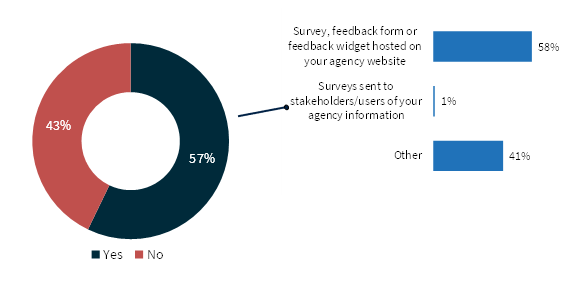
One-fifth (20%) of agencies reported they had identified good practices being used by other agencies to support the purposes of IPS (Figure 5).
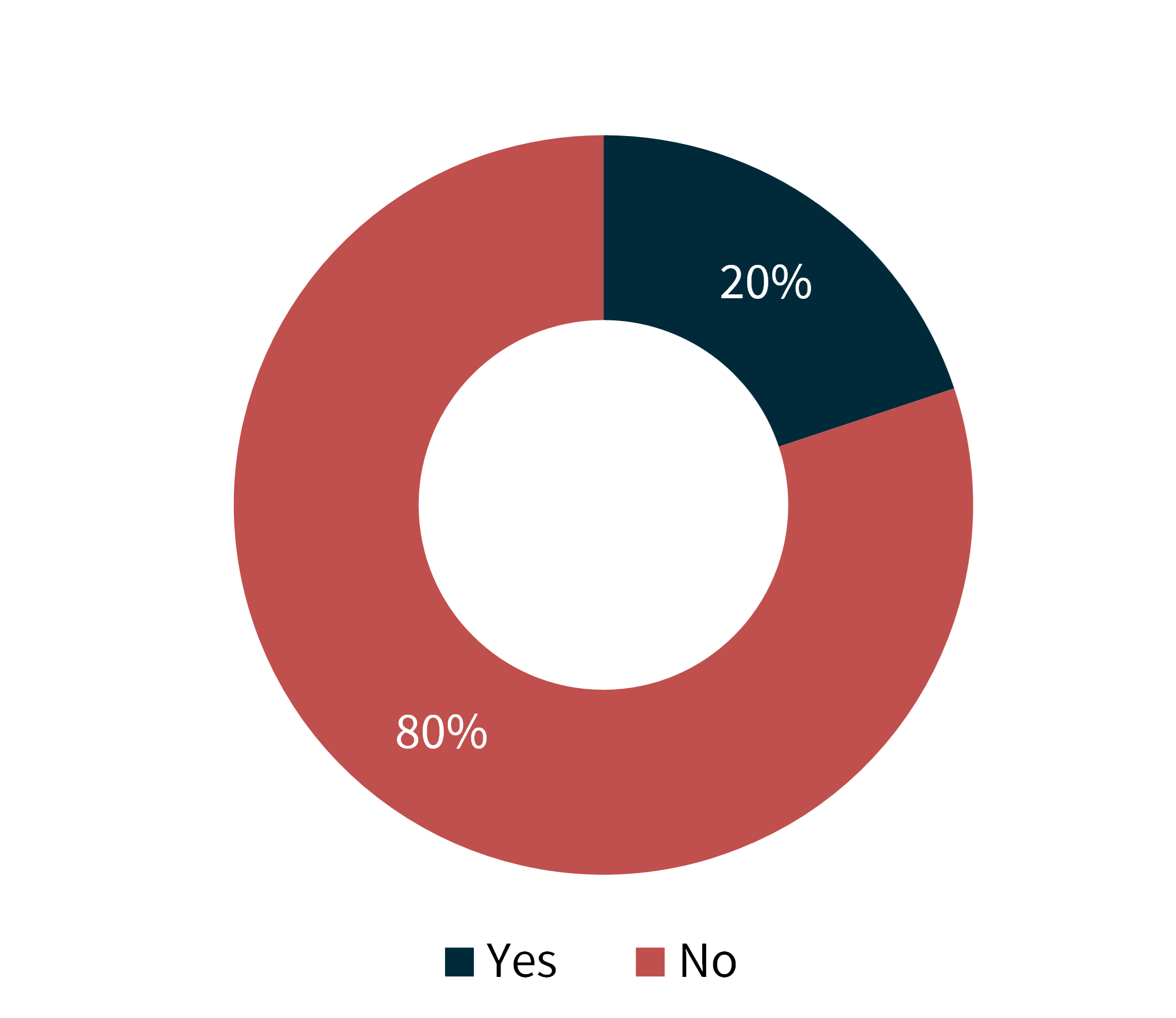
The most common examples of good practice that agencies had identified as being used by other agencies to support the purposes of the IPS included:
- best practice approaches to the presentation, layout and structure of information presented on agency websites (including use of headings, navigational links, content indexing and search functions):
‘Pages are clearly laid out, easy to follow, use recommended headings and meet the requirements of Part 13: Information Publication Scheme.’
- proactive publication/provision of open access to frequently requested information, data and statistics:
‘FOI statistics about routinely requested data and information.’
‘Publishing documents of frequently requested data.’
‘Proactive review of IPS to determine, with more frequency, types of information that could be published on the IPS even if not mandated under the legislation.’
- provision of information on agency websites about the frequency or timing of reviews of the IPS and contents of IPS plans.
Information Contact Officer Network (ICON)
62% of agencies have an Information Contact Officer who participates in ICON
Just over half of agencies indicated that they have an Information Contact Officer who participates in ICON[21]and they were most commonly identified as being located in the FOI (48%) and legal or litigation (27%) areas of their agency (Figure 6).
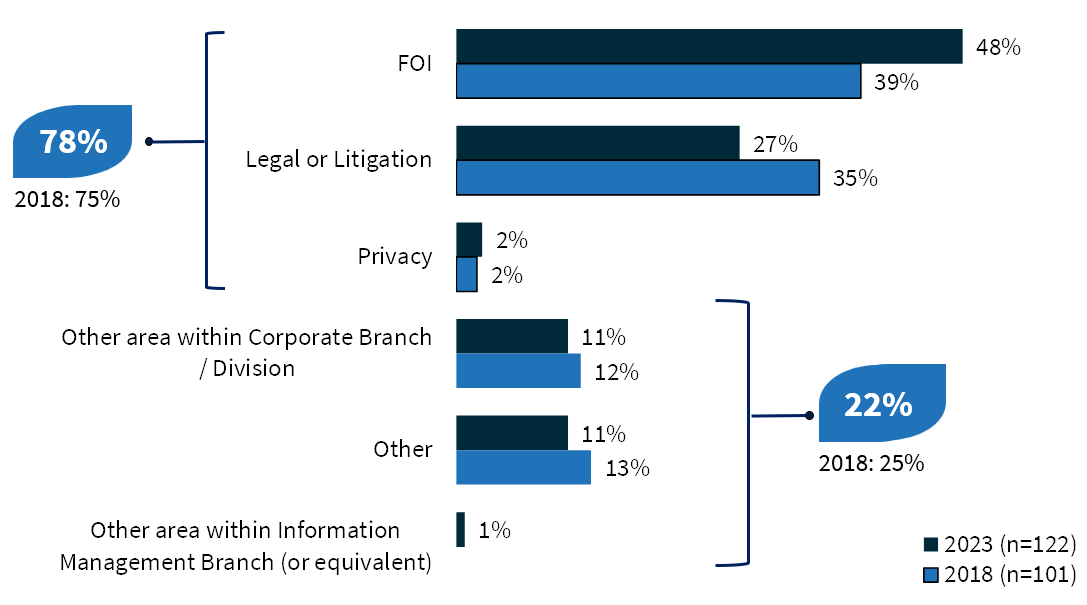
Further analysis of Information Contact Officers by agency characteristics
Extra large (100%) and large (85%) agencies were most likely to have an Information Contact Officer who participates in ICON, compared to smaller-sized agencies (23% for micro agencies and 46% for extra small agencies).
Agencies with a medium (68%), high (90%) or very high (90%) number of FOI requests were also more likely to have an Information Contact Officer that participates in ICON compared to those with nil (51%) or low (51%) numbers of FOI requests.
4.2 Agency IPS plan[22]
Agency IPS Plan published
90% of agencies have published an Agency IPS plan on their website
In 2023, 90% of agencies have published an Agency IPS plan, slightly higher than the 88% in 2018, but lower than the 94% reported in 2012[23]. Reasons for not publishing an IPS plan as reported by agencies included the plan currently being under review or in development, insufficient resources, and IPS Plan–related information being published across agency websites rather than as a discrete document.
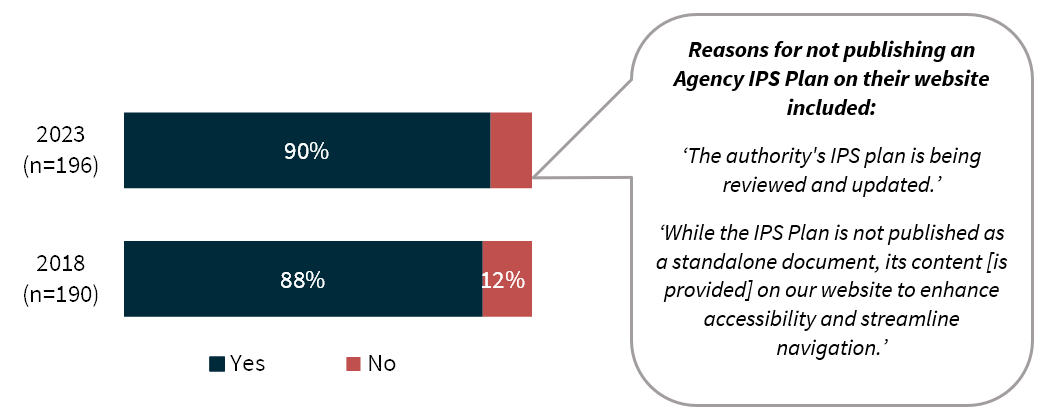
Further analysis of Agency IPS Plans published by agency characteristics
Micro agencies were the least likely to indicate that they have published an Agency IPS Plan on their website (77%) compared to larger agencies (80 to 98%).
Agencies with nil FOI requests were also the least likely to indicate they have published an Agency IPS Plan (82%), while those with very high numbers of FOI requests were most likely to publish a plan (100%).
Agency IPS Plan follows OAIC structure and content recommendations
81% of agencies use some or all of the standard recommended headings in their Agency IPS Plan
Eighty-one per cent of agencies use some or all of the standard recommended headings in their Agency IPS Plan. This proportion was lower than the 89% recorded in 2018 and 96% recorded in 2012. The proportion that indicated they use all 5 standard headings fell, from 81% in 2012 and 62% in 2018, to 37% in 2023. Nineteen per cent of agencies indicated they do not use any of the standard headings. Most agencies explained that they did not use these specific headings, but used similar headings that still reflected the intended content.
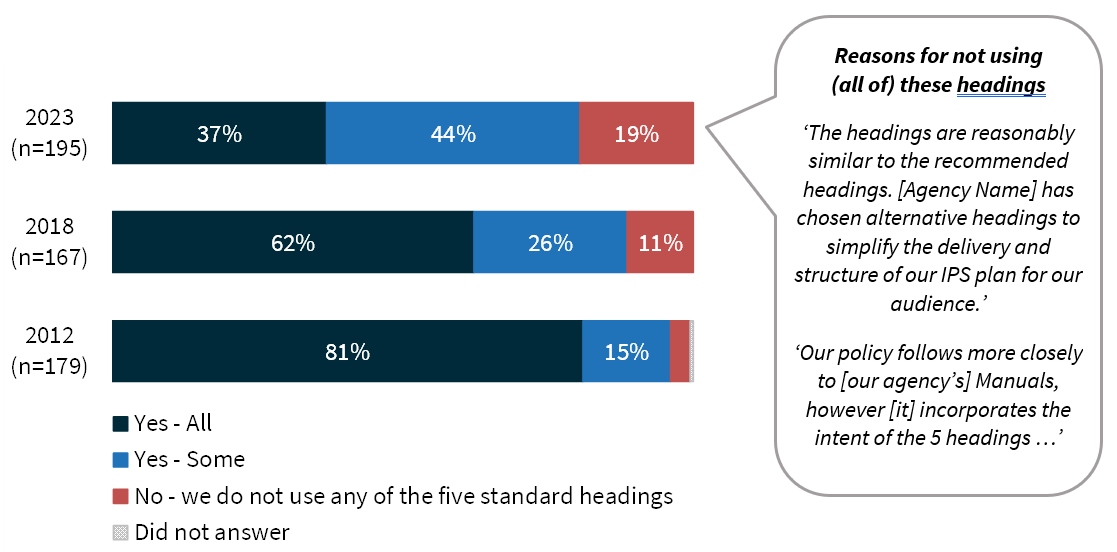
Update and maintenance of Agency IPS Plan
At least 60% of agencies indicated that their IPS Agency Plan included 7 of the 9 areas of recommended content outlined in the FOI Guidelines.
Paragraph 13.34 of the FOI Guidelines recommends that the Agency IPS Plan address the 9 matters outlined in Figure 9.
The survey showed that over 60% of agencies complied with the first 7 of these recommendations. However, the 2023 proportions of agencies that complied with these recommendations were consistently similar to or lower than proportions in previous years. This was most evident in the proportion of agencies whose IPS Agency Plan addressed measures being taken to ensure that the agency’s IPS entry is accurate, up-to-date and complete (67% in 2023, down from 80% in 2018 and 96% in 2012) and the proportion of agencies whose IPS Agency plan specified the senior executive officer currently responsible for leading the agency’s work on IPS compliance (67% in 2023, down from 72% in 2018 and 88% in 2012).
Around one-quarter or less of agencies indicated that their Agency IPS plan specifies:
- whether the agency has developed an internal IPS information register (26%, lower than 37% in 2018 and 54% in 2012)
- the measures (if any) being taken to improve the agency's information asset management framework to support its IPS compliance (22%, equal to the 2018 proportion but less than half the proportion in 2012 (57%)).
Further analysis of the coverage of recommended content in Agency IPS Plans by specific agency characteristics
The survey showed that in general, smaller agencies and those with a higher number of FOI requests were more likely to have at least some of the recommended content in their Agency IPS Plans. The results show that:
- agencies with no FOI requests were generally less likely to cover the recommended content than agencies with very high numbers of FOI requests (500+)
- 76% of agencies with no FOI requests addressed details of access charges (if any) imposed for accessing information published under the IPS, as well as how charges will be calculated (see 13.158 - 13.160 of the FOI Guidelines), slightly higher than agencies with very high numbers of FOI requests (70%)
- large and extra large agencies were less likely to specify the senior executive officer currently responsible for leading the agency's work on IPS compliance and the measures (if any) being taken to improve the agency's information asset management framework to support its IPS compliance than smaller agencies.
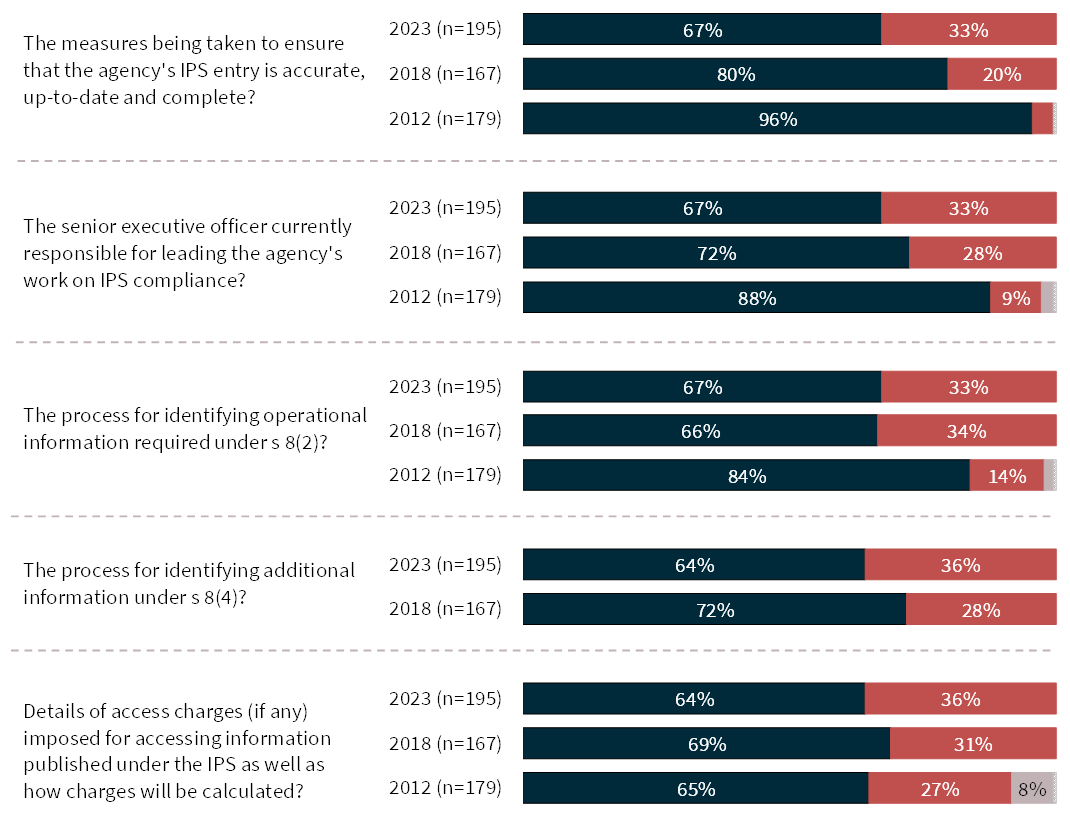
Does your Agency IPS Plan specify/address:
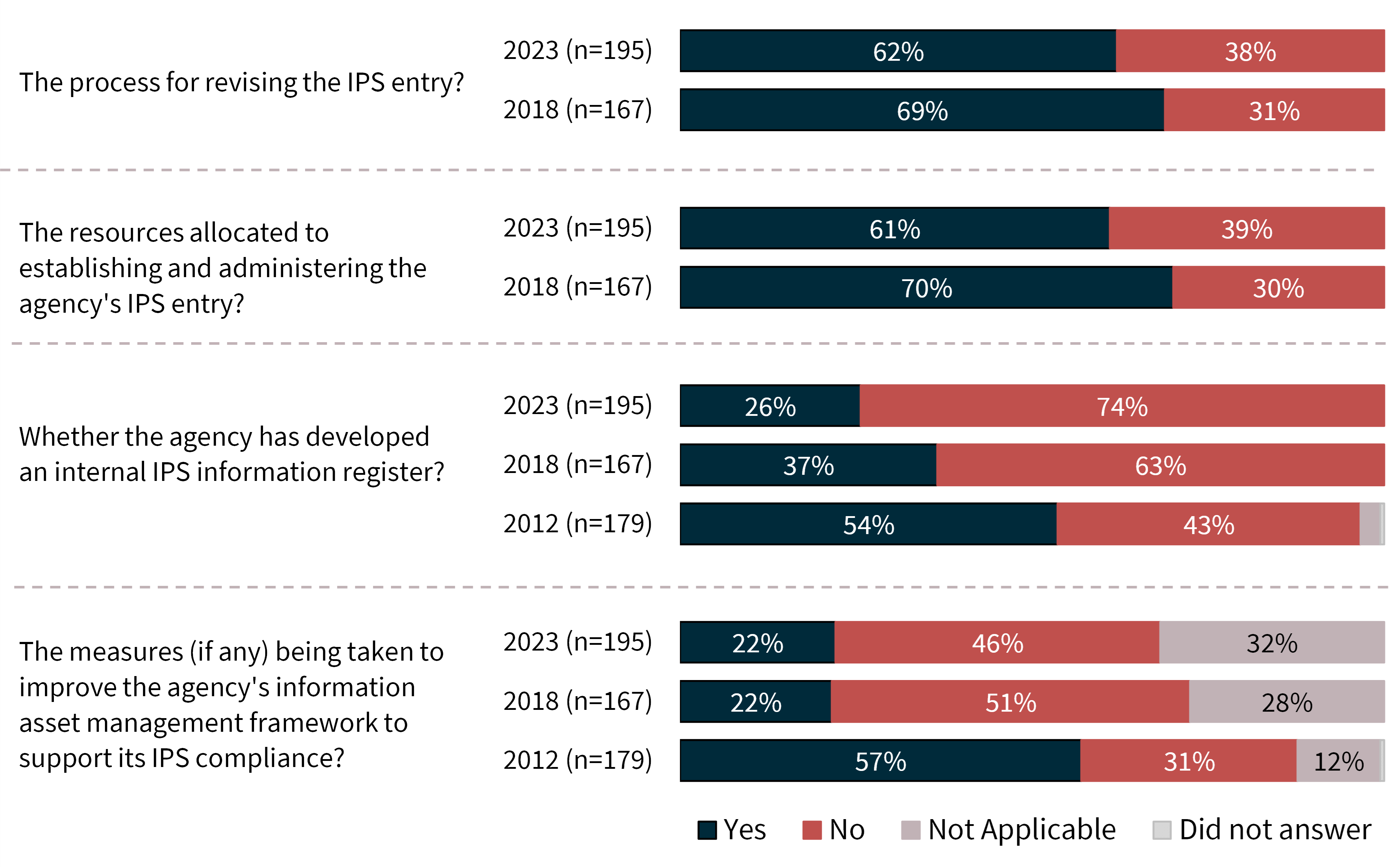
Does your Agency IPS Plan specify/address:

As shown in Figure 11 above, 39% of agencies updated their Agency IPS Plan less than one year ago and 37% updated their plan more than 2 years ago. Just under one-fifth of agencies indicated they have not updated their plan since it was first published and 79% of these agencies published this plan 5 or more years ago.
Sixty-one per cent of agencies have a timetable for formally reviewing their Agency IPS Plan – similar to the 62% recorded in 2018, but lower than the 90% recorded in 2012. Among agencies that have a timetable, 43% review their Agency IPS Plan on a regular basis but less often than every 12 months.
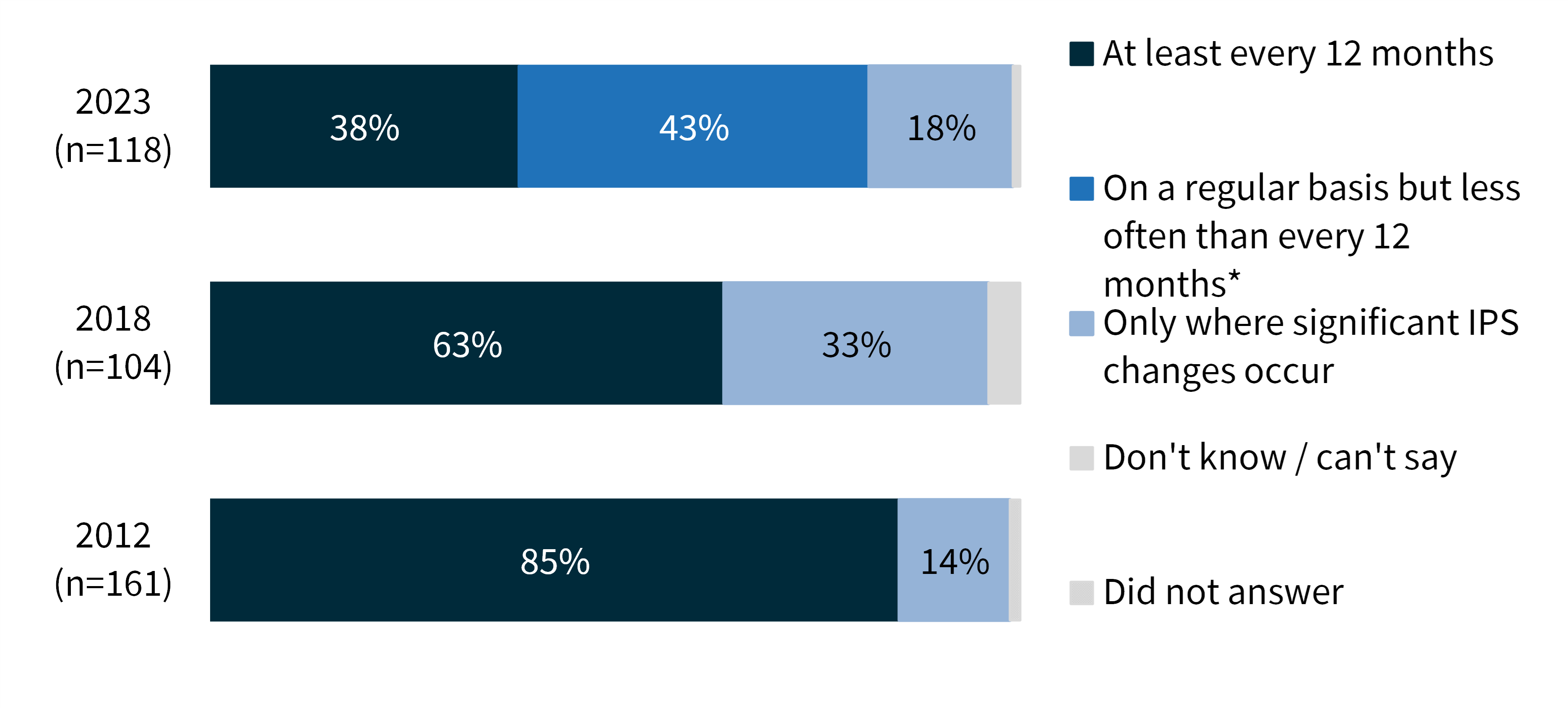
Following the changes to Part 13 of the FOI Guidelines in August 2023, 41% of agencies reported they reviewed these changes. Twenty-two per cent of agencies had not reviewed these changes but were aware of them, and 38% of agencies were not aware of these changes.
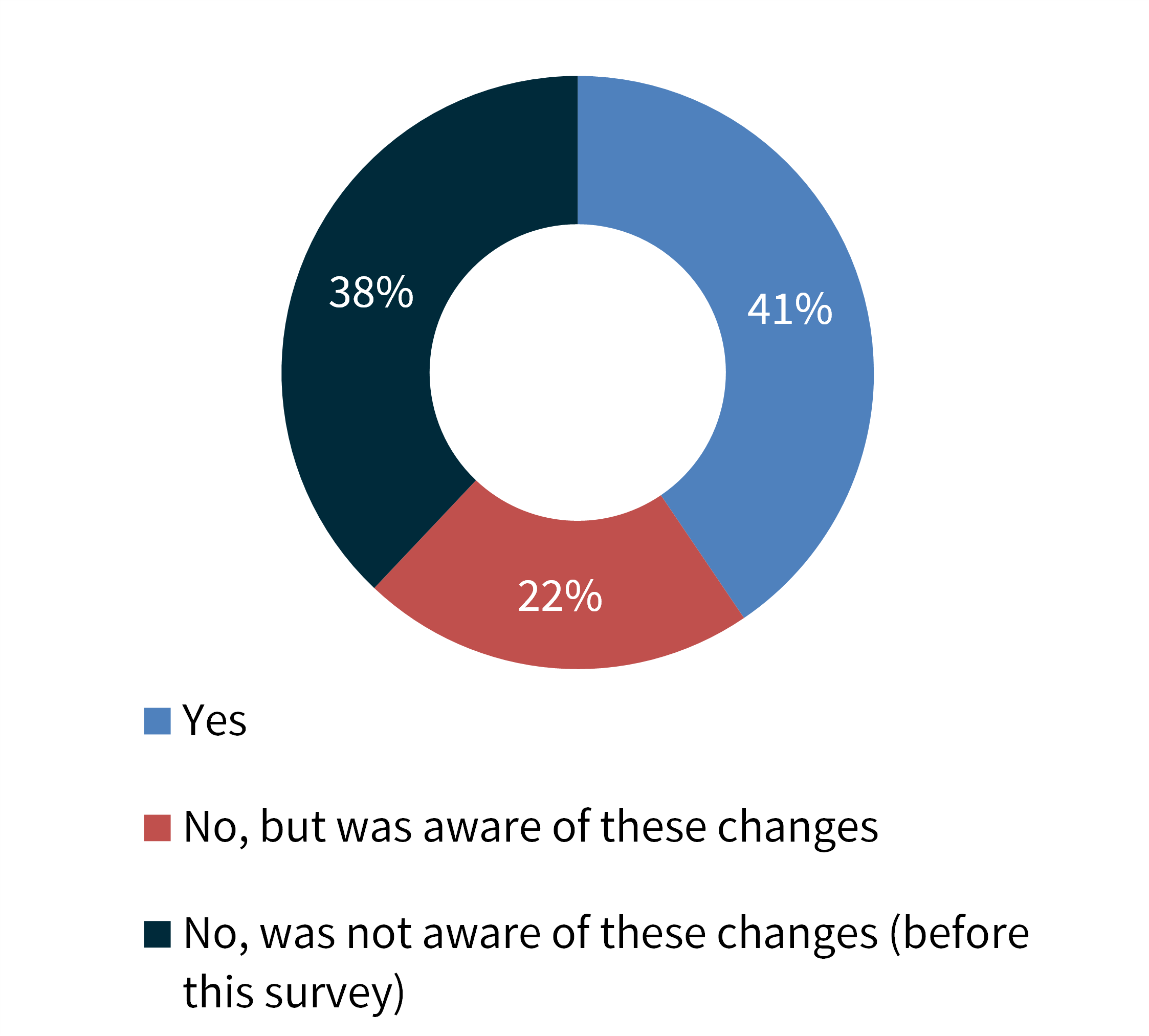
4.3 IPS governance and administration[26]
Governance/structural arrangements
78% of agencies have appointed a senior executive officer to lead the agency's work on IPS compliance
22% of agencies have a formal IPS governance structure
Seventy-eight per cent of agencies indicated they have appointed a senior executive officer to lead the agency’s work on IPS compliance. This result is higher than the 76% recorded in 2018, but lower than the 93% in 2012. Reasons for not appointing a senior executive officer among the 22% of agencies that did not do so included the impact of changes to their agency structure, resourcing restrictions, and their small size and characteristics (particularly for tribunals, authorities, and advisory committees).
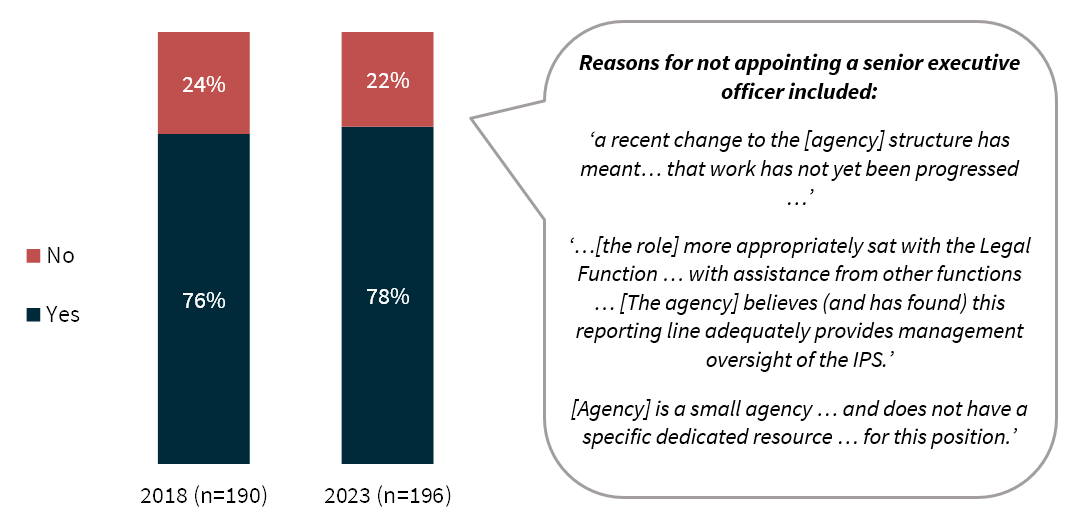
Further analysis of governance/structural arrangements by specific agency characteristics
All extra large agencies (100%), and 90% of agencies with a very high number of FOI requests, had appointed a senior executive with responsibility for leading the agencies’ work on IPS compliance, compared with 65 to 88% of comparatively smaller sized agencies and 54 to 95% of those with a lower number of FOI requests.Twenty-two per cent of agencies indicated they have a formal IPS governance structure, lower than 27% in 2018 and 47% in 2012. Among the 78% of agencies that did not have a formal IPS governance structure, the most common reasons for this were related to their agency size and resourcing constraints.
Among the 22% of agencies with a formal IPS governance structure, this was most likely to be some ‘other’ governance structure (60%). These ‘other’ governance structures included committees, boards and groups with broader responsibility than IPS, such as executive leadership and management teams and risk and legal teams. A relatively smaller proportion of agencies identified that their formal IPS governance structure(s) consisted of a working group (30%) and/or steering committee (12%).


Half of agencies reported that IPS work is shared across a team responsible for FOI, and 33% of agencies reported IPS work was shared across different team units and individuals. Only 4% of agencies reported IPS work was performed by a dedicated IPS Officer (Figure 17). Sixty-five per cent of staff who worked on IPS work were at the Executive Level 1 level, with over half at the APS 5–6 (56%) and Executive Level 2 (55%) levels (Figure 18).
Base: All agencies (n=195)
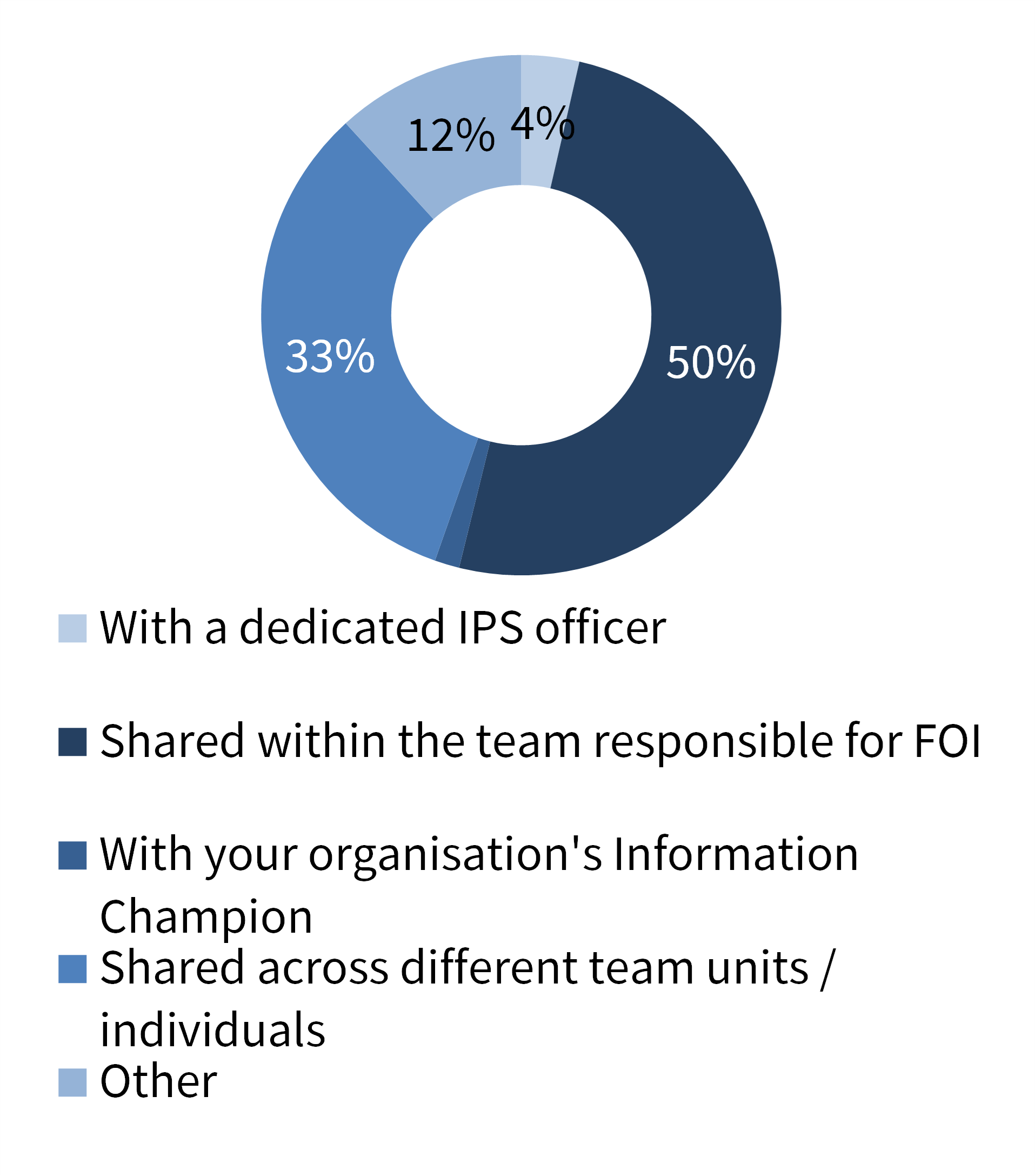
Base: All agencies (n=195)

Further analysis of IPS governance structures by specific agency characteristics
Agency size was cited as one of the main reasons that agencies did not have a formal IPS governance structure, and this was reflected in the quantitative survey data, particularly among extra small (14%) and micro (19%) agencies that were the least likely to indicate that they have a formal IPS governance structure, compared to relatively larger agencies (20–29%).
IPS policies and procedures
55% identify and prepare documents for IPS publication
58% publish IPS documents
Fifty-five per cent of agencies indicated they have policies and procedures in place to identify and prepare documents for IPS publication (less than 67% in 2018 and 78% in 2012) and 58% indicated they have policies and procedures in place to publish IPS documents (less than 74% in 2018 and 81% in 2012).
Further analysis of IPS policies and procedures by specific agency characteristics
Extra large agencies (100%) were more likely than relatively smaller agencies (49–68%) to have policies and procedures in place to publish IPS documents. Extra large agencies (80%) were also more likely to identify and prepare documents for IPS publication compared to relatively smaller agencies (43–62%).
Resources allocated to IPS functions
Number of staff allocated to IPS functions

In 2023, there were 1,027 staff allocated to IPS functions across 194 agencies – an average of 5 staff per agency. This is higher than the average of 3 staff recorded in 2018, but consistent with the average of 5 staff recorded in 2012.
Further analysis of resources allocated to IPS functions by specific agency characteristics
Extra large agencies recorded a higher average number of staff allocated to IPS functions (22 staff) compared to relatively smaller sized agencies (average of 3-7 staff). Agencies with a very high number of FOI requests recorded the highest average (18 staff) compared to agencies with nil, low, medium and high numbers of FOI requests (average ranged from 3-8 staff).
Staff training undertaken/staff awareness developed
55% of agencies have assigned responsibility for the management or coordination of staff training and awareness of IPS obligations
Over half (55%) of agencies have assigned responsibility for the management or coordination of staff training and awareness of IPS obligations – similar to the 54% in 2018, but lower than 73% in 2012.[28] Areas where this responsibility has been assigned as described by agencies included corporate governance, corporate services, legal services and freedom of information teams.
Sixteen per cent of agencies indicated induction training for new staff includes information on the IPS (in line with 16% in 2018, but lower than 23% in 2012). Agencies generally described this type of information as references or mentions of IPS requirements as part of induction training.


Figure 20 shows that 17% of agencies provide staff with other specific training on IPS obligations, lower than the 25% in 2018 and 49% in 2012. Among agencies that provide staff with other specific training, they were most likely to do so via on the job training (52%, lower than the 45% in 2018 and 65% in 2012), self-paced online training (27%, compared with 15% in 2018 and zero% in 2012) and specific formal training (for example in-person or online courses conducted live by a trainer) (3%, lower than 13% in 2018 and 9% in 2012).
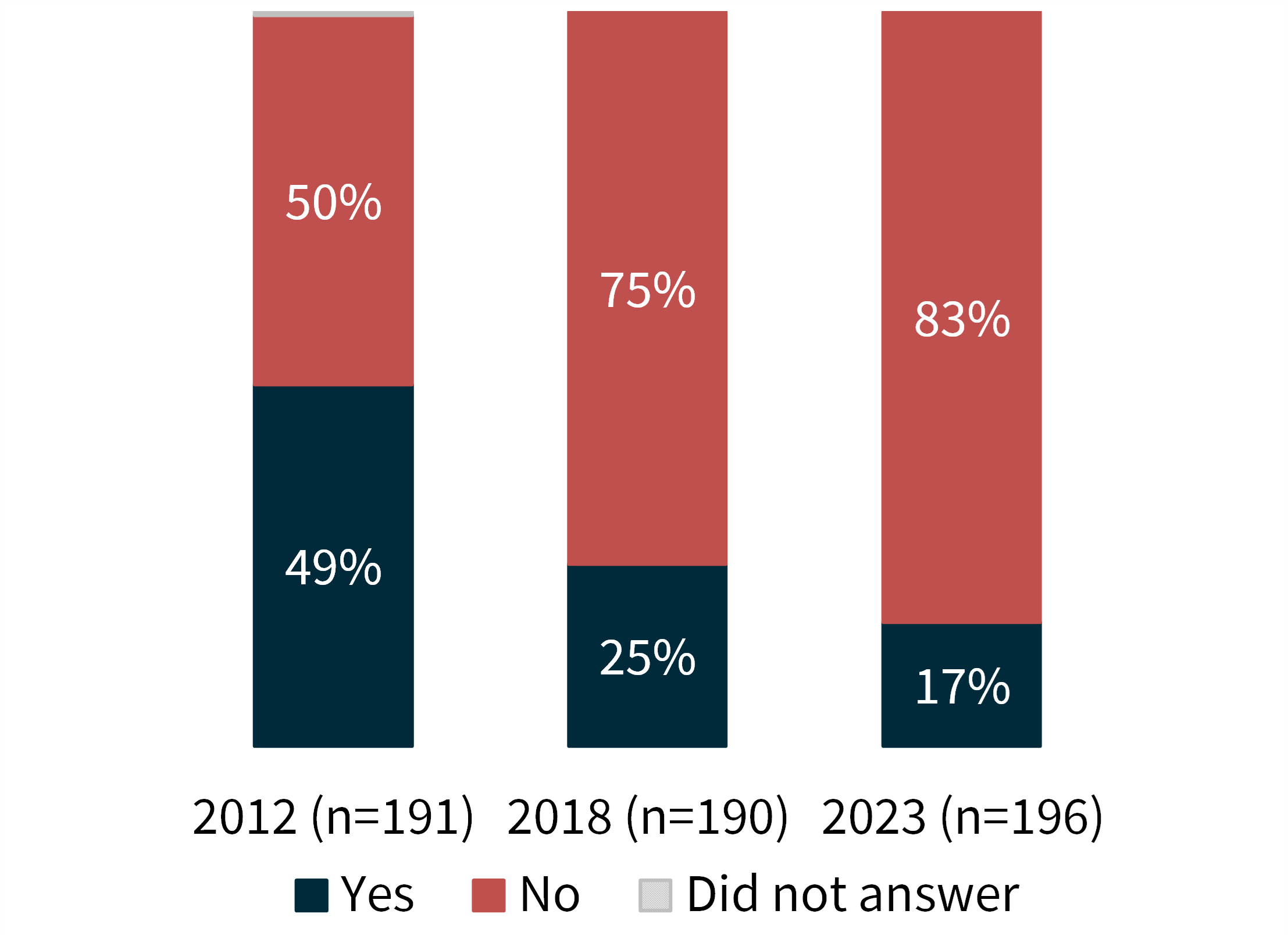
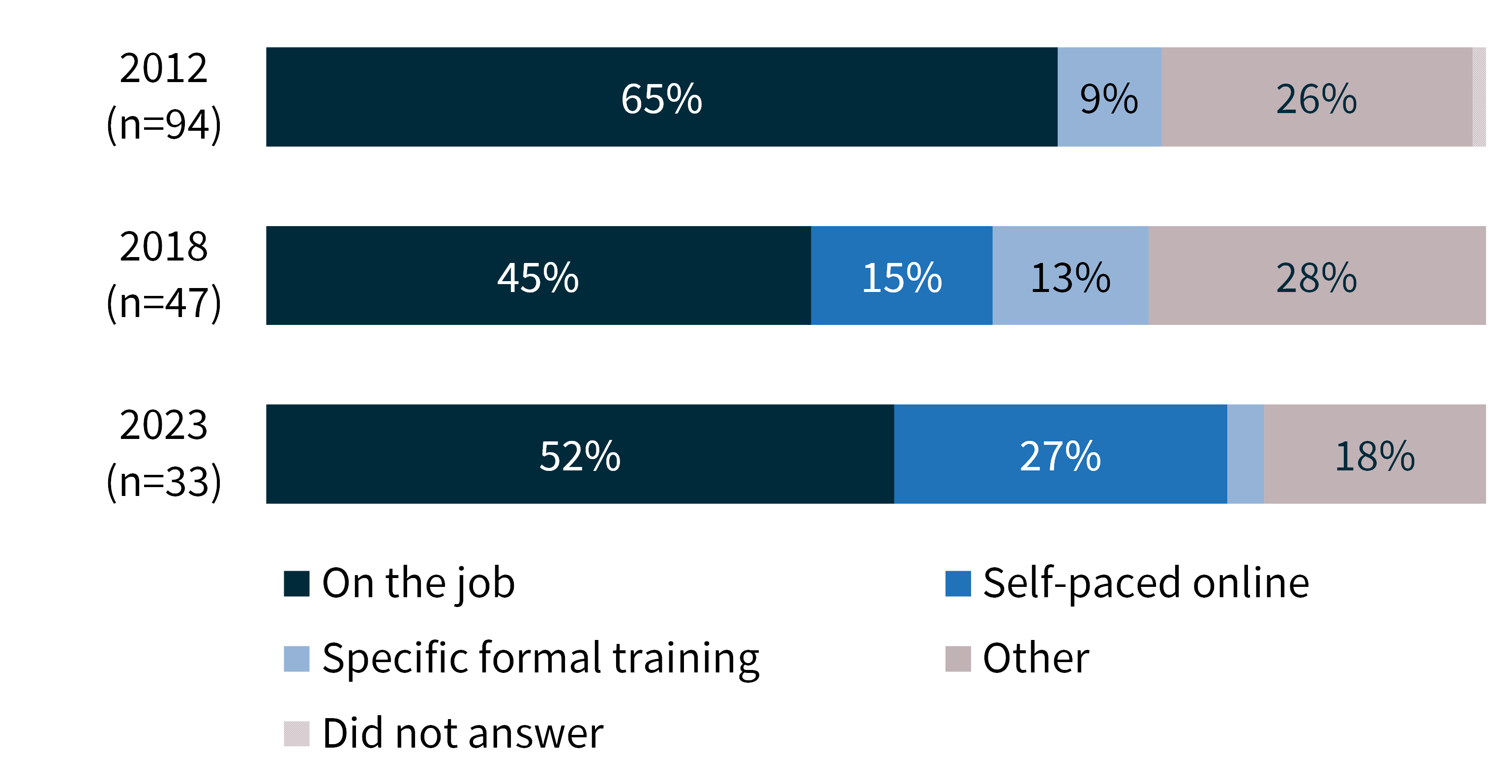

Further analysis of staff training undertaken/awareness developed by specific agency characteristics
There were variations in the extent to which staff training has been undertaken and awareness developed by agency size:
- both micro (38%) and extra large agencies (40%) were less likely to assign responsibility for management of staff training and awareness of IPS obligations compared with other agencies (48 to 68%)
- similarly, micro (4%) and extra large (0%) agencies were less likely to include information on the IPS in their induction training for new staff than other agencies (13 to 26%)
- however, extra large agencies were more likely to provide staff with other specific training on IPS obligations than smaller agencies.
There was also variation by the number of FOI requests:
- agencies with very high numbers of FOI requests were slightly more likely to indicate that the management or coordination of staff training and awareness of IPS obligations within the agency has been assigned (60%), compared to smaller agencies (51% to 59%)
- agencies with medium numbers of FOI requests were more likely to include IPS information in new staff induction training (27%) than those with very high (10%) or no FOI requests (5%)
- agencies with no FOI requests were less likely to provide staff with other specific training on IPS obligations (3%) than other agencies (16-25%).
4.4 IPS entry[29]
Information required to be published
Over 70% of agencies publish each of the required types of information on their website
Figure 22 below shows that in 2023, over 70% of agencies indicated they publish each of the types of information required to be published under s 8(2) of the FOI Act on their website. Information relating to annual reports, agency’s functions and decision-making powers, contact details for FOI information, organisation structures, and information released in response to FOI access requests via an Agency Disclosure Log were most commonly published (each of these types of information was published by at least 95% of agencies in 2023, which remains broadly similar to the results recorded in 2018 and 2012).
However, around 10% or more of agencies indicated they do not publish the other types of information required to be published under the FOI Act and the proportion indicating that they publish the other types of information required to be published declined since 2012 (where comparable).
The results suggest in 2023, the proportion of agencies that published the types of information required by the FOI Act were similar to or slightly improved from 2018, but generally lower than 2012 proportions. These types of information included:
- information released in response to FOI access requests via an Agency Disclosure Log – s 11C (95%, slightly up from 91% in 2018)
- appointments of agency officers made under Acts (91%, down 85% in 2018 and equal to the 2012 percentage)
- operational information – the rules, policies, principles, and procedures that agencies apply in making decisions or recommendations that affect members of the public (87%, slightly up from 84% but down from 94% in 2012)
- information held by agencies that they routinely provide to Parliament in response to requests and orders from the Parliament (82%, equal to the 2018 proportion but slightly down from 86% in 2012)
- information in documents to which agencies routinely give access in response to requests under Part III of the FOI Act – s 8(2)(g) (73%, down from 79% in 2018 and 86% in 2012)[30]
- consultation arrangements for members of the public to comment on specific policy proposals for which the agency is responsible (75%, slightly up from 72% in 2018 but down from 86% in 2012).
Does your agency publish on its website details of:
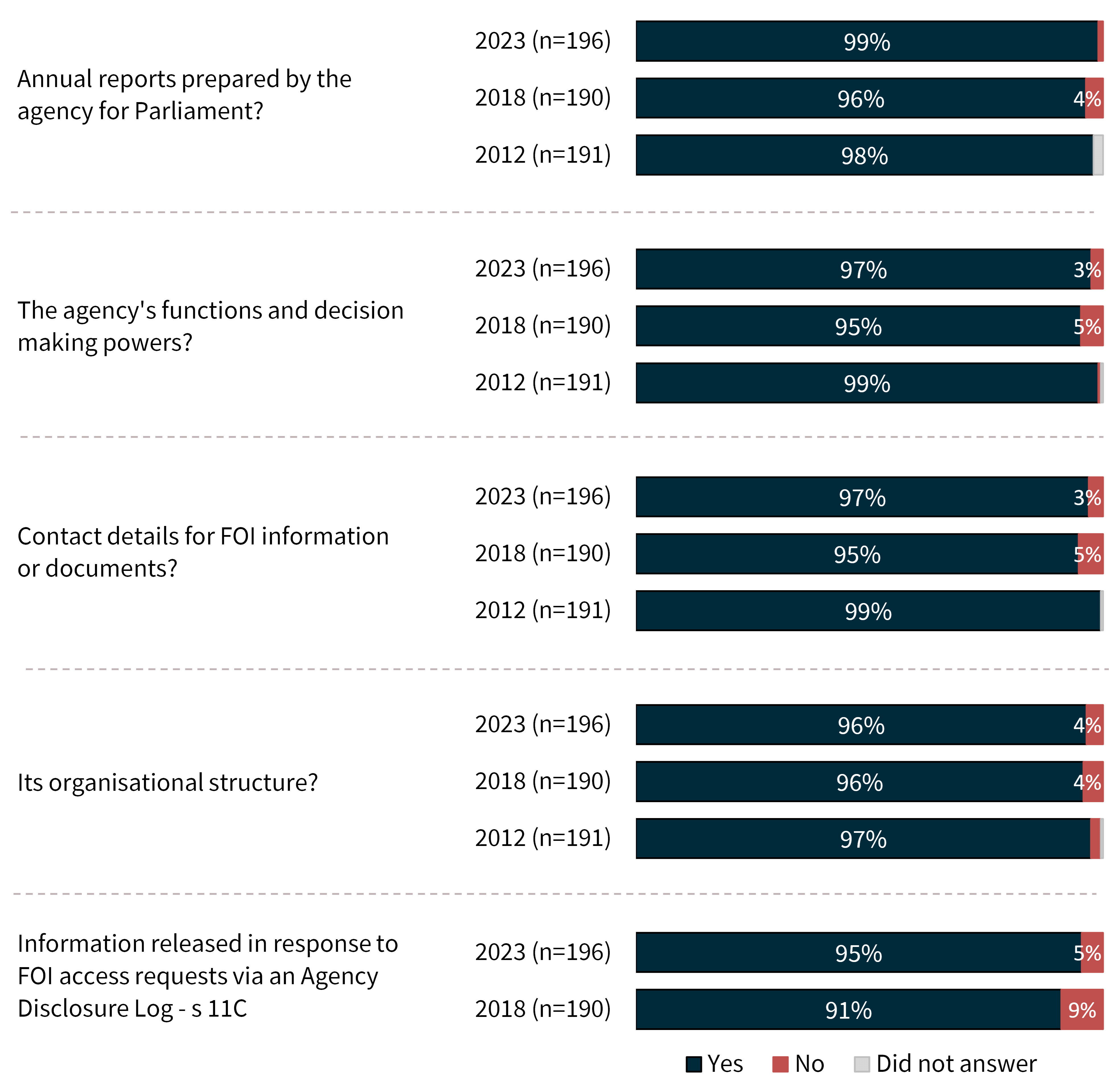
Base: All agencies
Does your agency publish on its website details of:
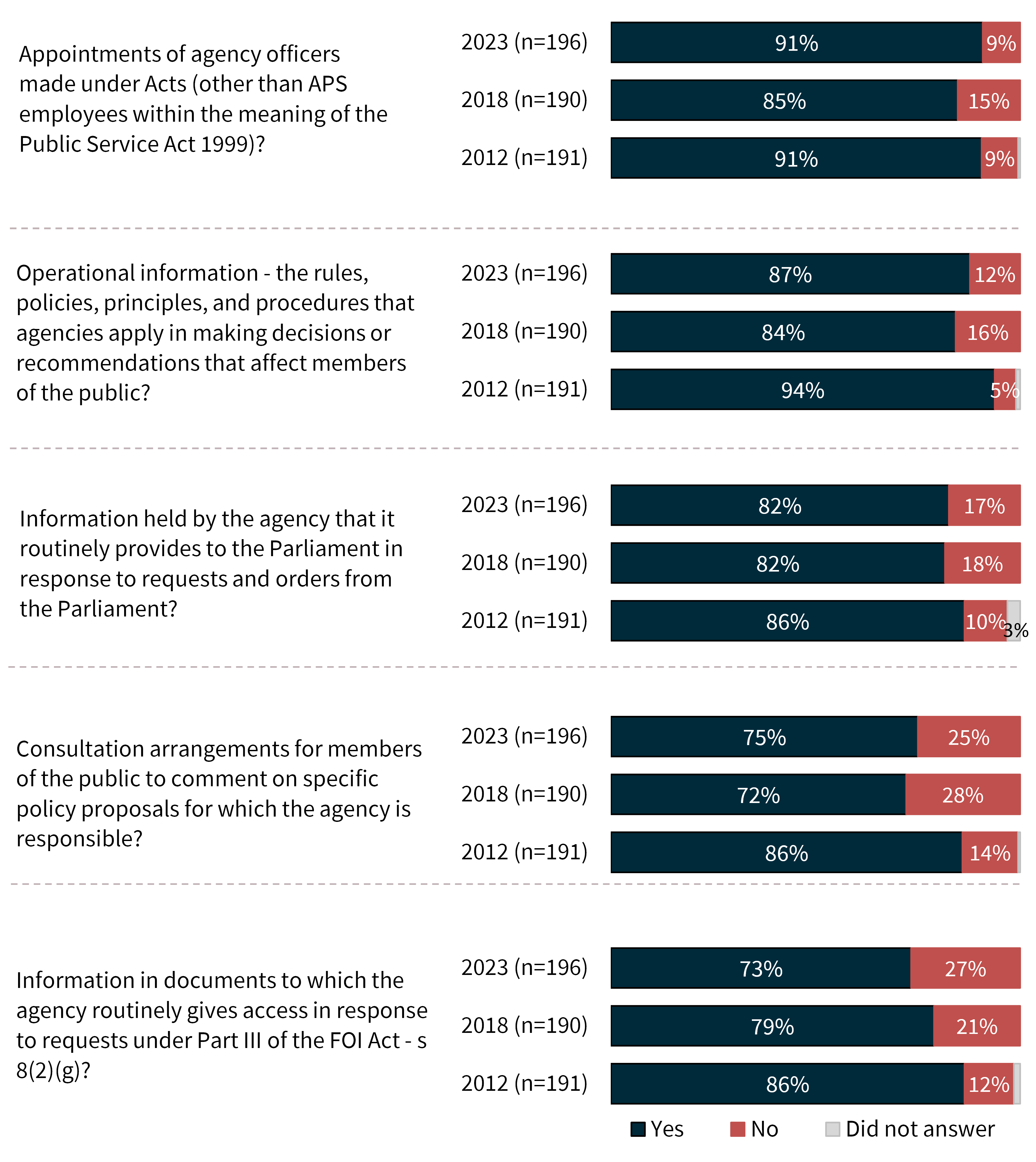
Further analysis of information required to be published by specific agency characteristics
There was some variation in the likelihood of agencies publishing each of the types of information required to be published under s 8(2) of the FOI Act on their website by agency size:
- micro agencies were generally the least likely to publish details on their website including details of their organisational structures (81%, compared with 97 to 100% in larger agencies) and information released in response to FOI access requests via an Agency Disclosure Log – s 11C (73%, compared to 97 to 100% for larger agencies)
- large agencies were generally more likely to publish the types of information required to be published under s 8(2) of the FOI Act than other agency sizes.
There was some variation by the number of FOI requests, where agencies with:
- no FOI requests were generally the least likely to indicate they publish each of the required types of information on their website, especially for information released in response to FOI access requests via an Agency Disclosure Log – s 11C and information held by the agency that it routinely provides to the Parliament in response to requests and orders from the Parliament
- agencies with high or very high numbers of FOI requests were more likely to publish the types of information required to be published under s 8(2) of the FOI Act than agencies with lower numbers of FOI requests.
Other information to be published under the IPS
42% of agencies have mechanisms for identifying other information that can be published under the IPS
Forty-two per cent of agencies indicated they have mechanisms for identifying other information that can be published under the IPS. This result is down from 59% in 2018 and 71% in 2012. These agencies indicated the other information they publish under the IPS included information about strategic plans, information released under administrative access arrangements, scientific datasets, statistics, research reports, financial statements, and submissions to Parliament.
Seventy-eight per cent of agencies believed there would be no change to the number of FOI requests their agencies receive if proactive publication under the IPS was increased. A further 14% believed they would experience a small increase in requests if proactive publication was increased, and 5% believed they would experience a small decline in FOI requests (Figure 24).
Fifty-two per cent of agencies had a clear approach to releasing routinely requested statistics such as an agency’s service delivery performance. Around one-third (31%) of agencies indicated this approach was not applicable to them, and 11% of agencies reported they did not have a clear approach, nor was it under development (Figure 25).
Base: All agencies (n=196)
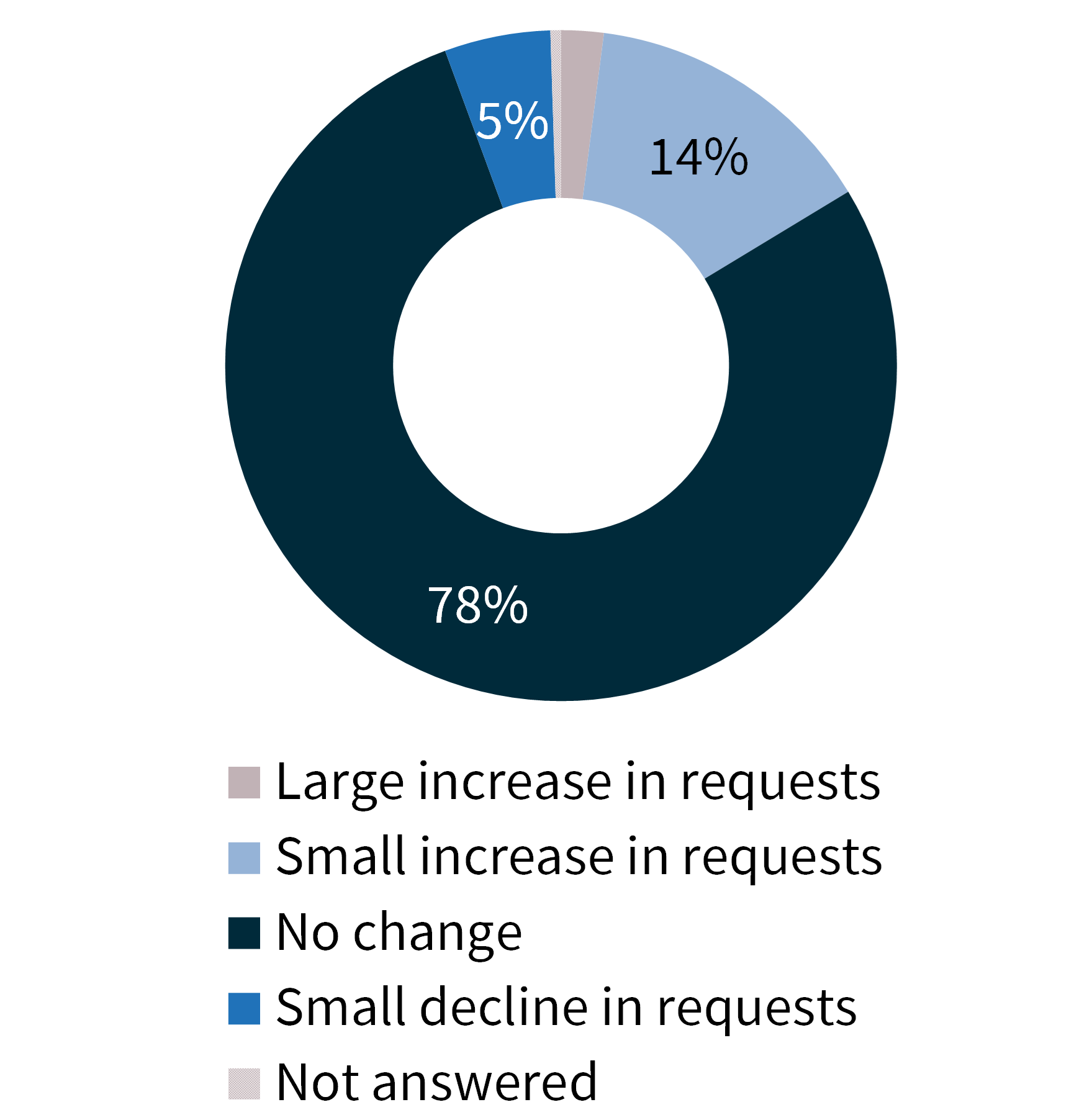
Base: All agencies (n=196)
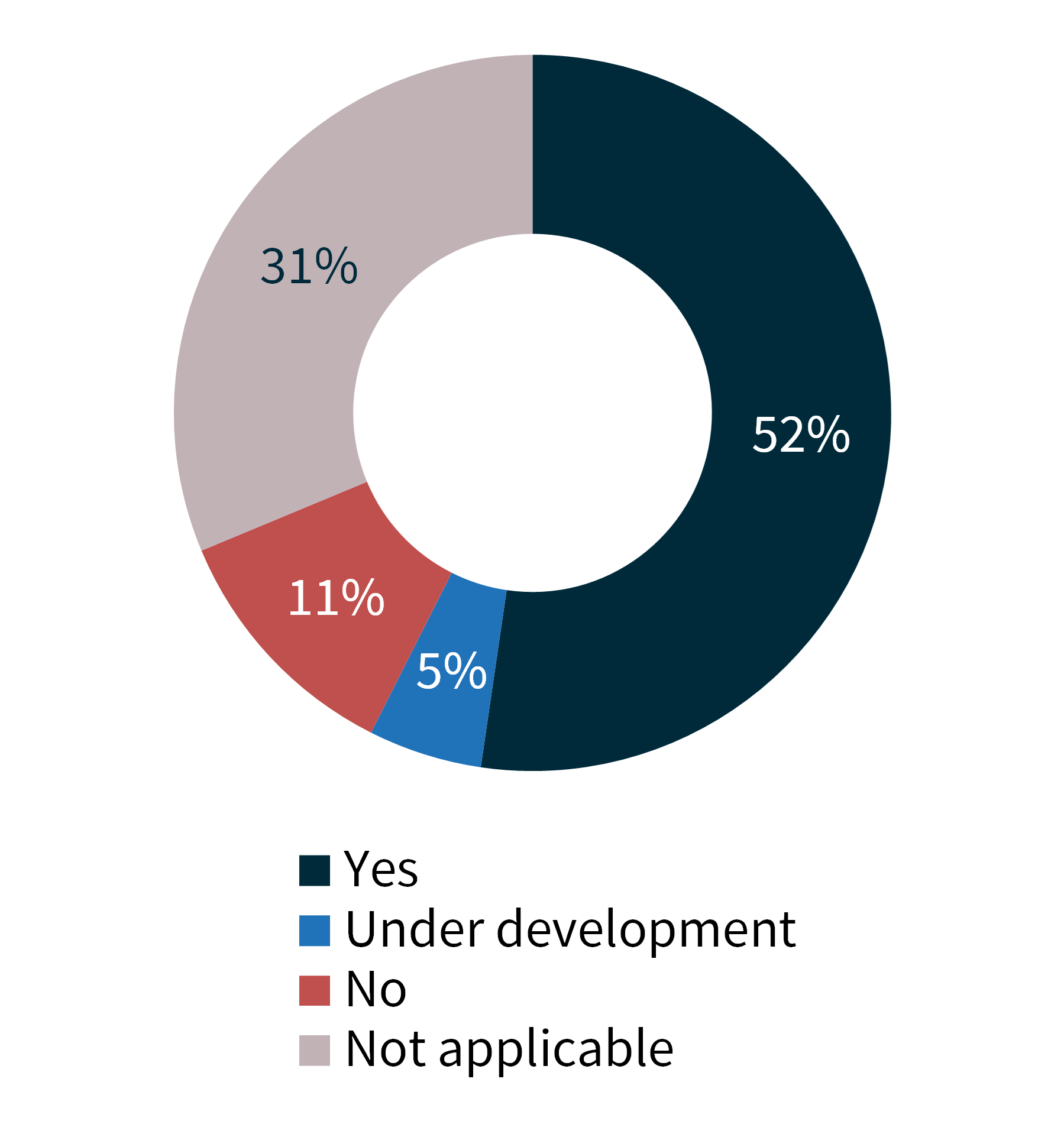
Thirty-five per cent of agencies reported their agency provides guidance and information to its staff about how to identify what ‘other’ information can be published under the IPS as outlined in s 8(4) of the FOI Act and Part 13 of the Guidelines (Figure 26).
Base: All agencies (n=196)
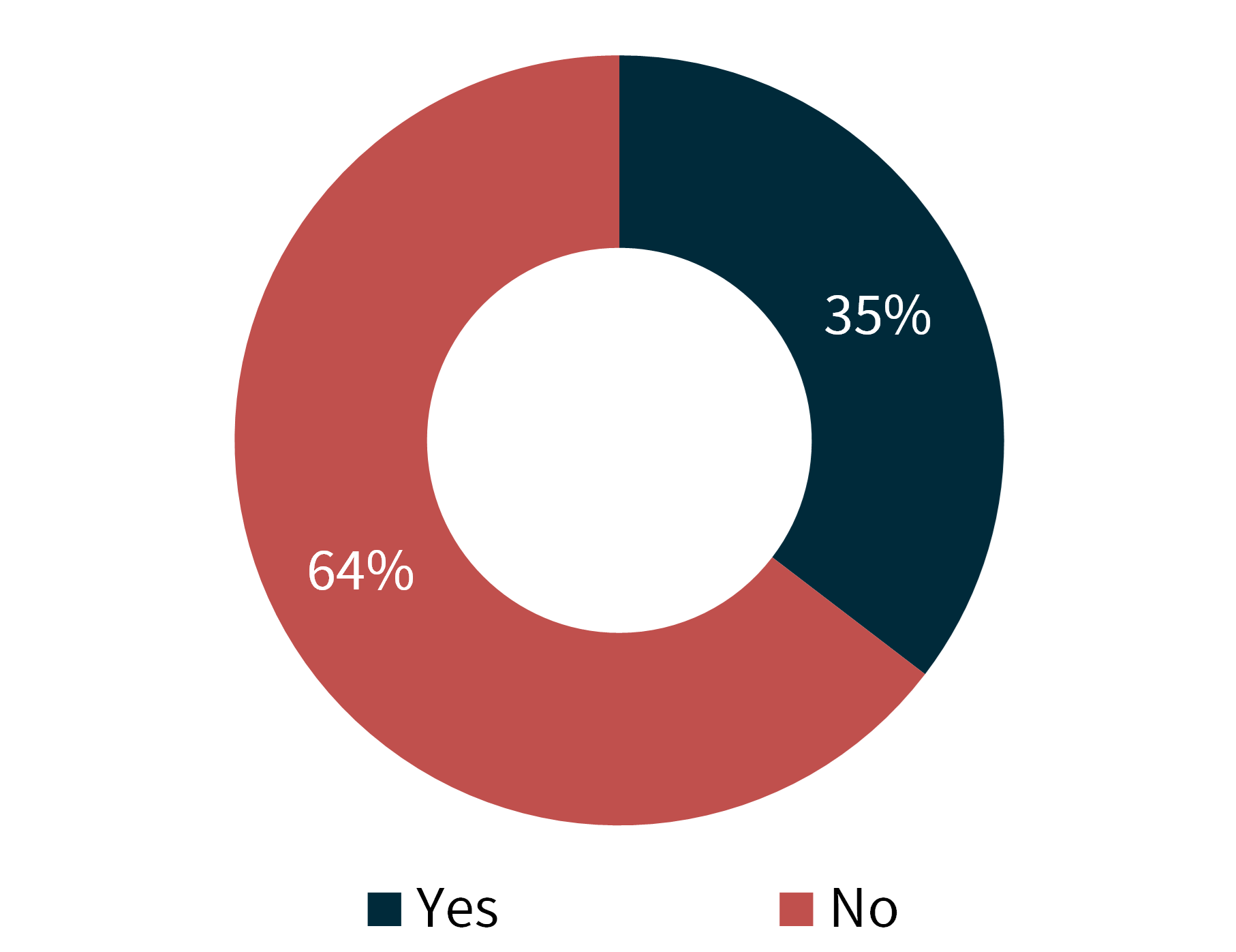
Further analysis of other information to be published under the IPS by specific agency characteristics
The extent to which other information is published under the IPS varied by agency size and the number of FOI requests:
- agencies with high (57%) or very high (60%) numbers of FOI requests were more likely to indicate they have a mechanism for identifying other information which can be published under the IPS compared to agencies with smaller numbers of FOI requests (21 to 46%)
- extra large agencies were much more likely to have a mechanism for identifying other information that can be published under the IPS (80%) compared with smaller agencies (38 to 48%).
Exceptions – personal and business information
34% of agencies have made a decision not to publish information under the IPS due to the exception for publication of personal or business information
Thirty-four per cent of agencies indicated they have made a decision not to publish information under the IPS due to the personal or business information exception under s 8(2)(g)(i) or (ii) and is lower than the 42% in 2018 and 36% recorded in 2012. Among agencies that have made this decision, 20% maintain an IPS information register[31]and less than half (46%) of these agencies record decisions not to publish information recorded in their IPS information register (Figure 27).
Base: All agencies
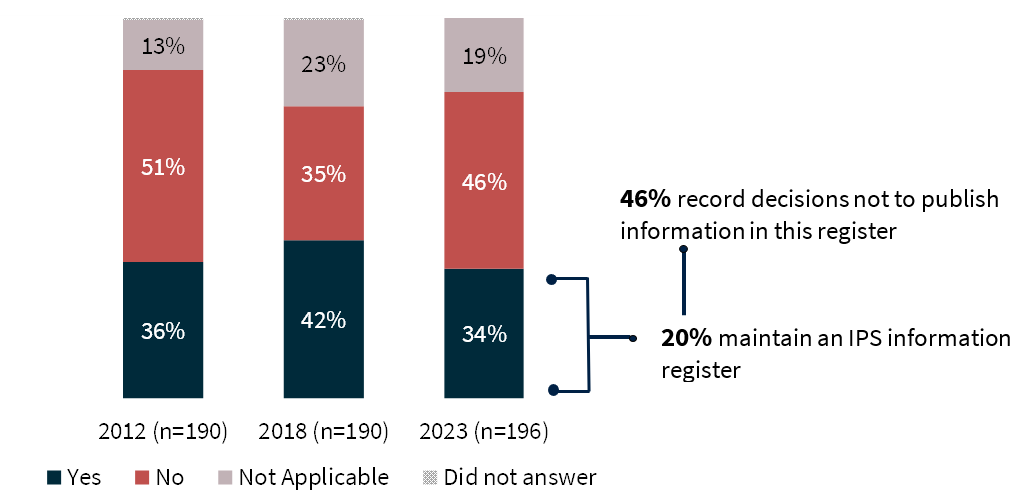
Further analysis of exceptions (personal and business information) by specific agency characteristics
The extent to which agencies have made a decision not to publish information under the IPS due to the personal or business information exception under s 8(2)(g)(i) or (ii), varied according to agency size and the number of FOI requests. The likelihood of making this decision to not publish, increased significantly with agency size (from 23% (micro agencies) to 60% (extra large agencies)) and number of FOI requests (from 31% (nil number of FOI requests) to 90% (very high numbers of FOI requests).
IPS information register[32]
20% of agencies maintain an IPS information register
34% of agencies intend to develop an IPS information register in the next 12 months
In 2023 among the 20% of agencies that maintain an IPS information register, 33% indicated that their agency’s IPS information register is reviewed only when significant IPS changes occur. Smaller proportions indicated this review is conducted at least every 6 months (20%) or 12 months (28%) – see Figure 28 and Figure 29.
Base: All agencies
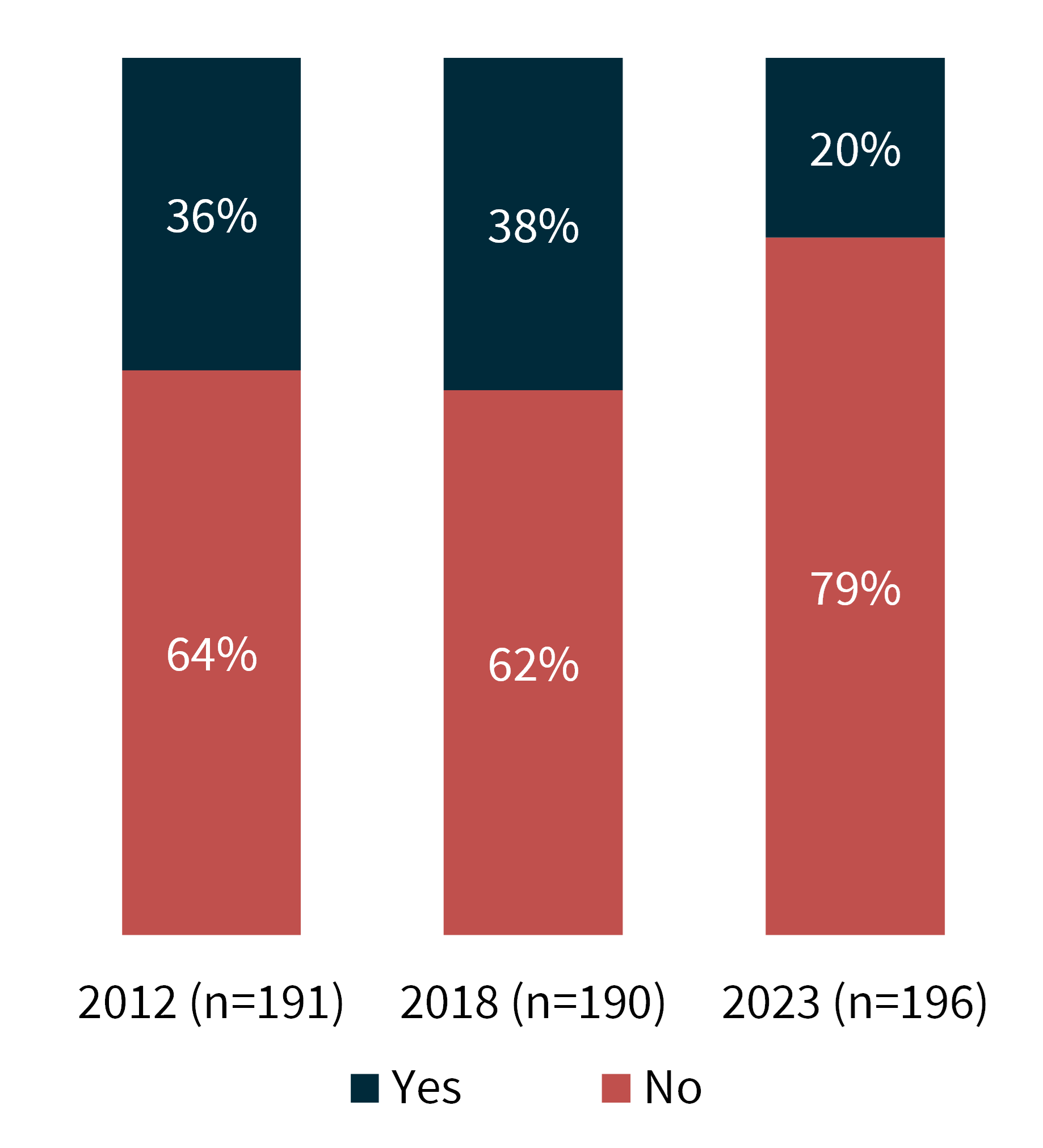
Base: Agencies that maintain an IPS information register
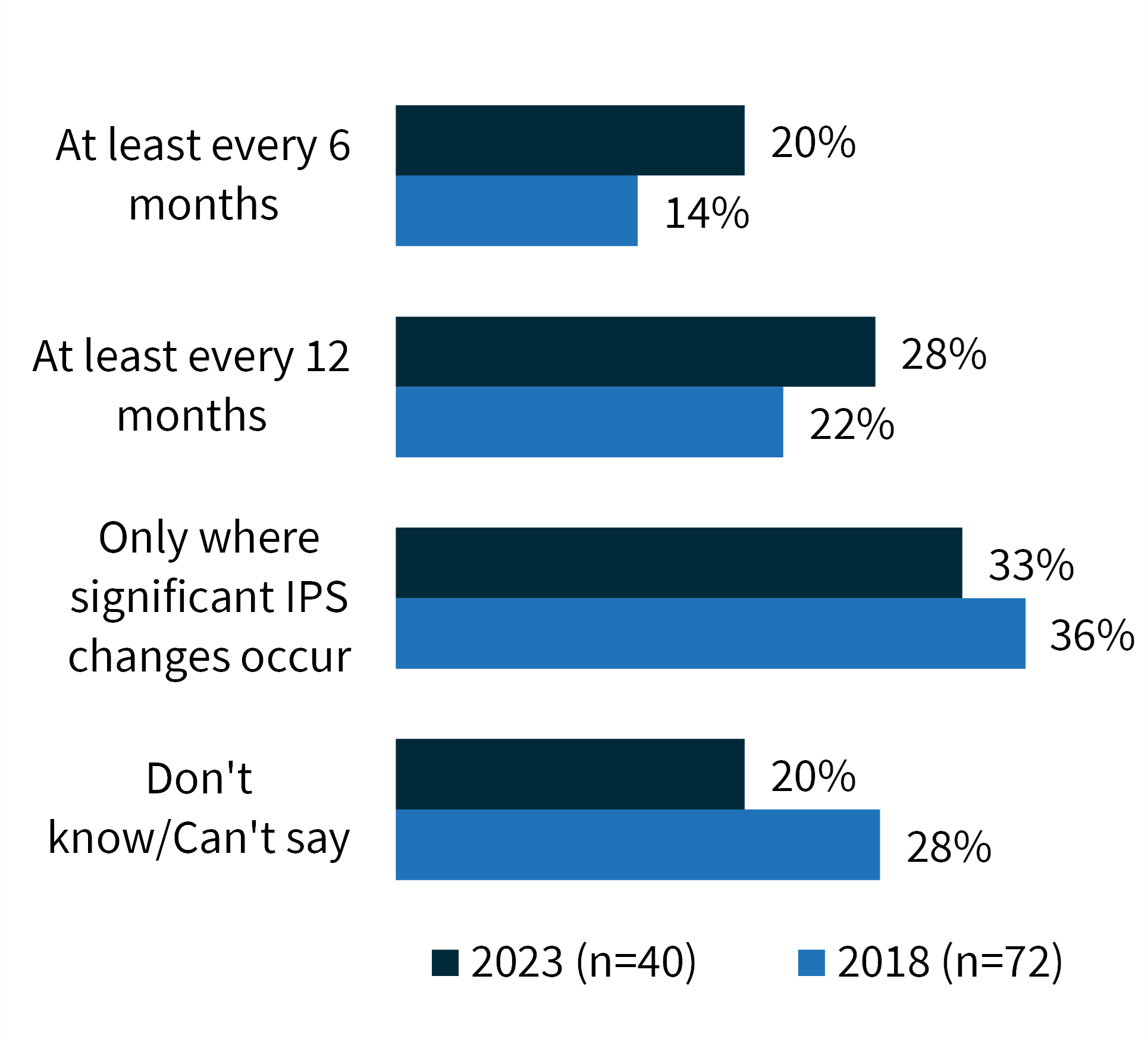
Fees and charges
57% of agencies have a policy that specifies or covers its approach to charging for access to information under the IPS
As shown in Figure 30, the majority (82%) of agencies in 2023 do not charge for information required (s 8(2)) or permitted (s (8(4)) to be published under the IPS. This is slightly higher than 73% in 2018 and 68% in 2012. The proportion of agencies that charge for information required was only 4%, unchanged from 2018 and below 12% in 2012.
Base: All agencies
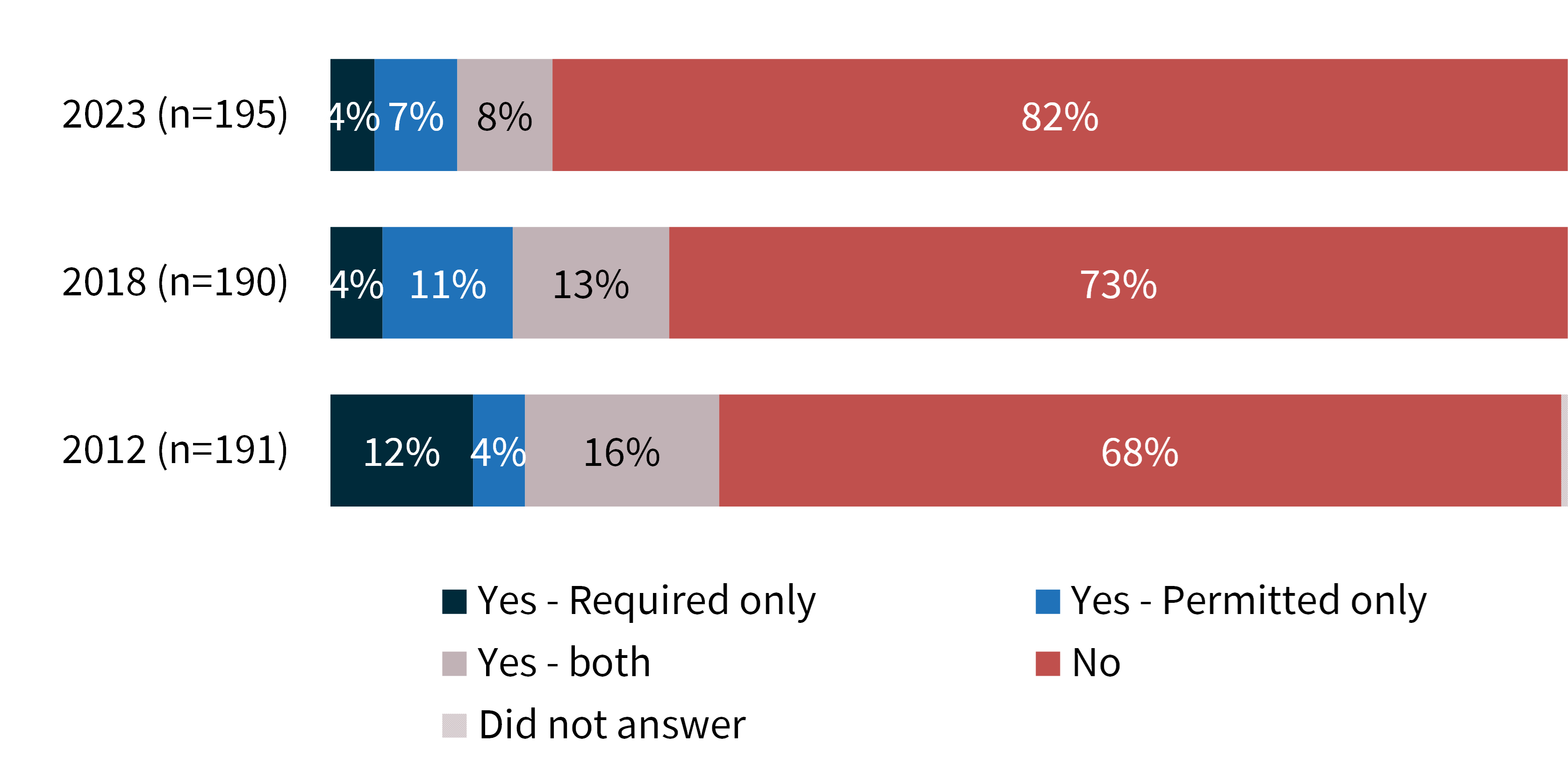
Eighty-six per cent of agencies use the FOI Charges Regulations[33] for calculating and imposing a charge for access under the IPS in 2023, lower than 94% in 2018 and 93% in 2012.
The survey also found that a considerable minority of agencies impose fees and charges for reasons outside those allowed under the FOI Act.
- 20% of agencies indicated that the charge was not for providing access to information that cannot be downloaded from a website – consistent with the proportion in 2018 (19%), and lower than the proportion in 2012 (30%).
- 9% of agencies indicated that the charge was not for reimbursing the agency for specific reproduction (or other incidental) costs associated with giving access – a decrease from the 19% recorded in 2018 and similar to 8% in 2012.
- 17% of agencies did not publish details of these charges on their website, similar to 21% in 2018 and 18% and 2012.
Further analysis of fees and charges for information under the IPS by specific agency characteristics
Approaches to imposing fees and charges for information under the IPS varied according to agency size and the number of FOI requests:
- large (68%) agencies were most likely to have a policy that specifies or covers its approach to charging for access to information under the IPS (compared to 40 to 58% for relatively smaller agencies)
- agencies with no FOI requests were more likely to have a policy specifying or covering their approach to charging for access to information under the IPS (69%) than those with very high numbers of requests (50%)
- agencies with high (90%) or very high (90%) numbers of FOI requests were more likely to not charge for information required (s 8(2)) or permitted (s 8(4)) to be published under the IPS compared with other agencies (77 to 86%)
- the likelihood of agencies using the FOI Charges Regulations for calculating and imposing a charge for access under the IPS generally increased with agency size and number of FOI requests.
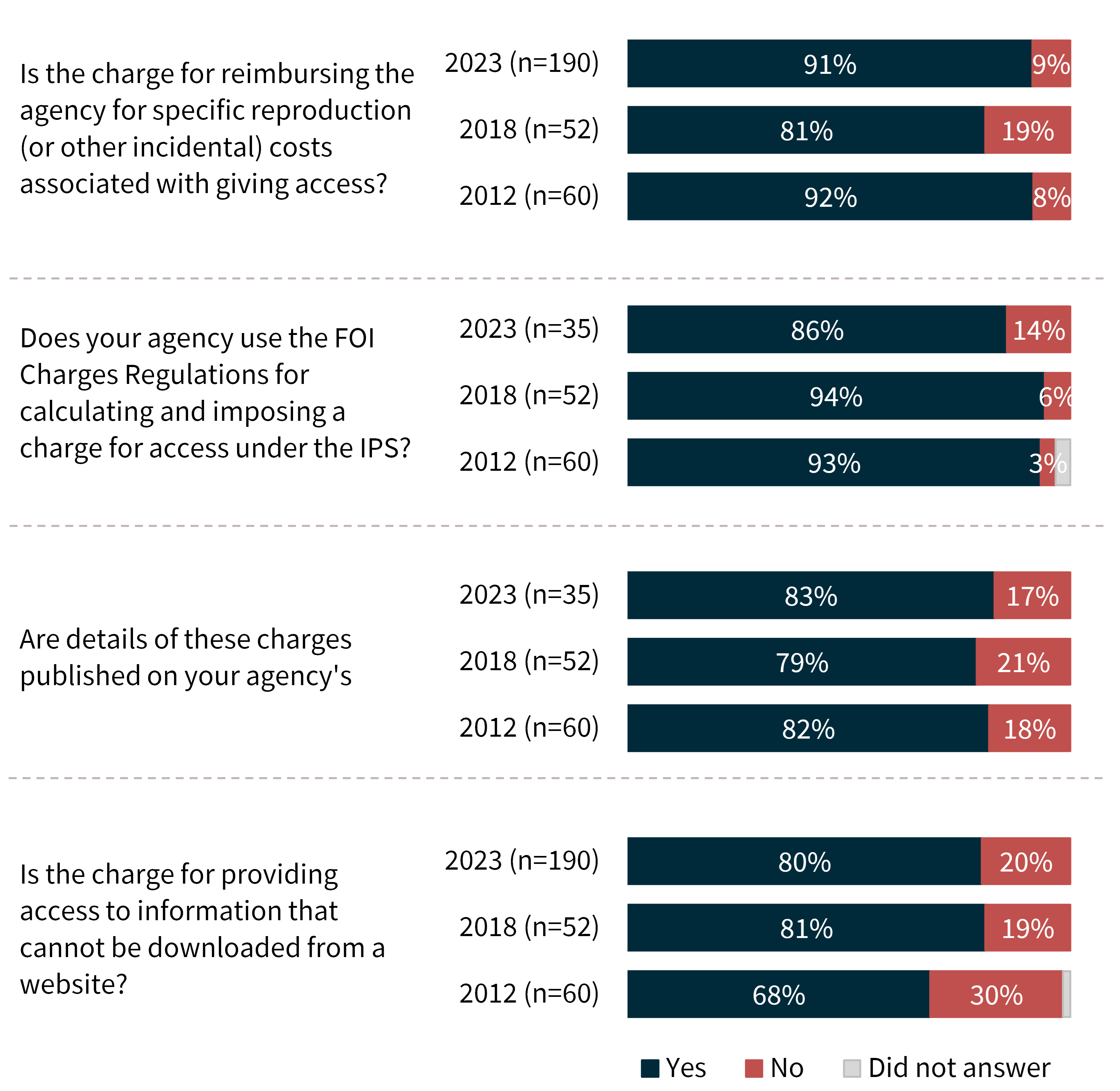
4.5 Structure of the IPS[34]
Use of recommended standardised headings and structure
More than 70% of agenciesuse 6 out of the 10 recommended standardised headings and structure
Although agencies are not required to use the headings or language specified in the FOI Act for presenting their IPS information, the Information Commissioner published FOI Guidelines[35] in October 2011 advising that it would be easier for the public to access agency information if there was a consistent format of publication on agency websites.
The FOI Guidelines recommend the use of 10 headings for the Agency Publication Framework.
Figure 32 and Figure 33 show that:
- more than 70% of agencies used 6 out of the 10 recommended headings – this is consistent with the proportion identified in 2018, but lower than 2012 where more than three-quarters of agencies used 7 out the 10 recommended headings
- the proportion of agencies using each recommended heading in 2018 was generally similar to 2018 proportions but less than 2012 proportions for the most commonly used headings
- less than two-thirds of agencies used the remaining headings. One-quarter (25%) of agencies use the heading ‘Our lists – s 8(4)’ (down from 39% in 2018 and 49% in 2012). One-third (33%) of agencies used the heading ‘Our finances – s 8(4)’ in 2023 (down from 46% in 2018 and 51% in 2012).
Base: All agencies
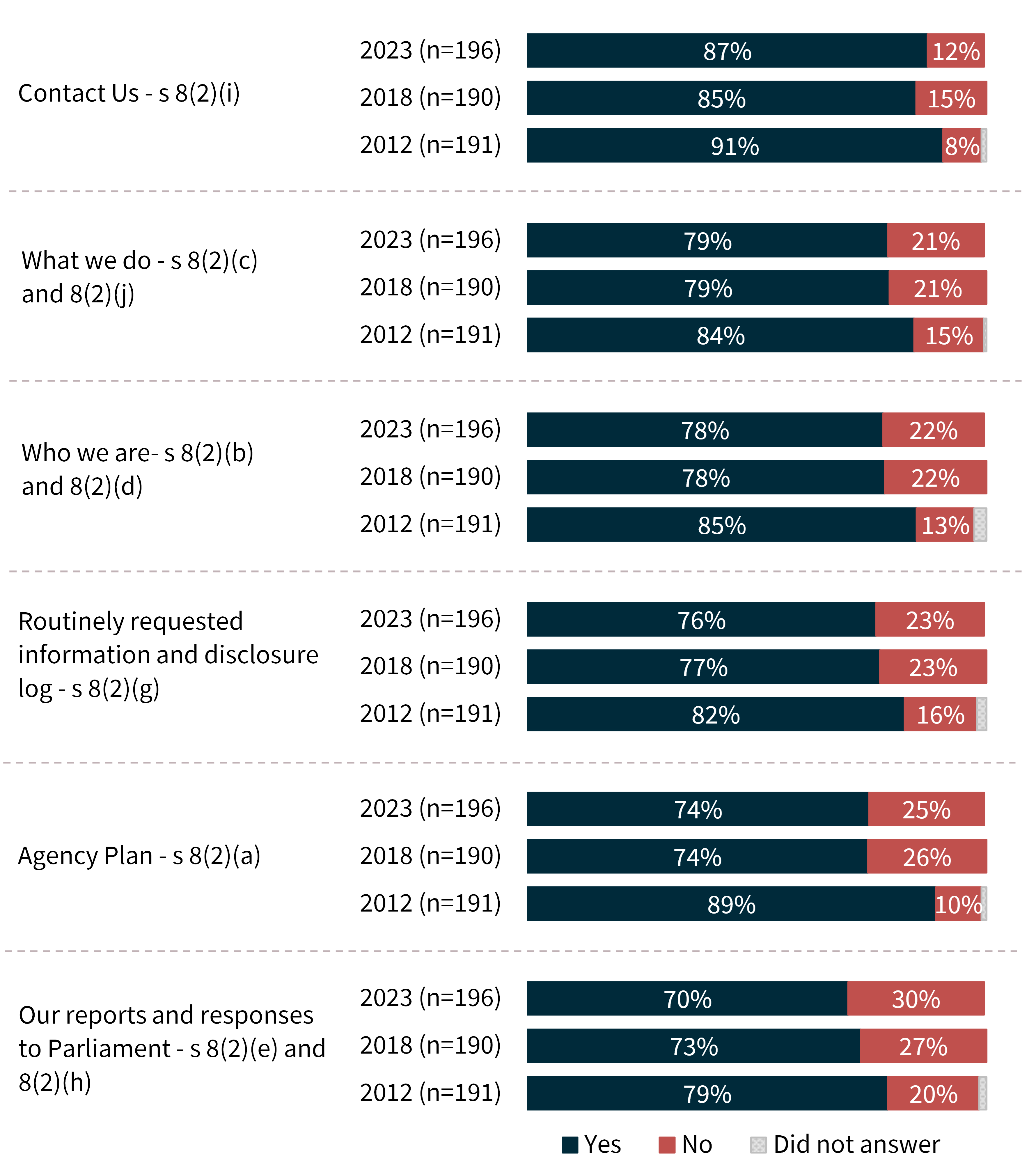
Base: All agencies
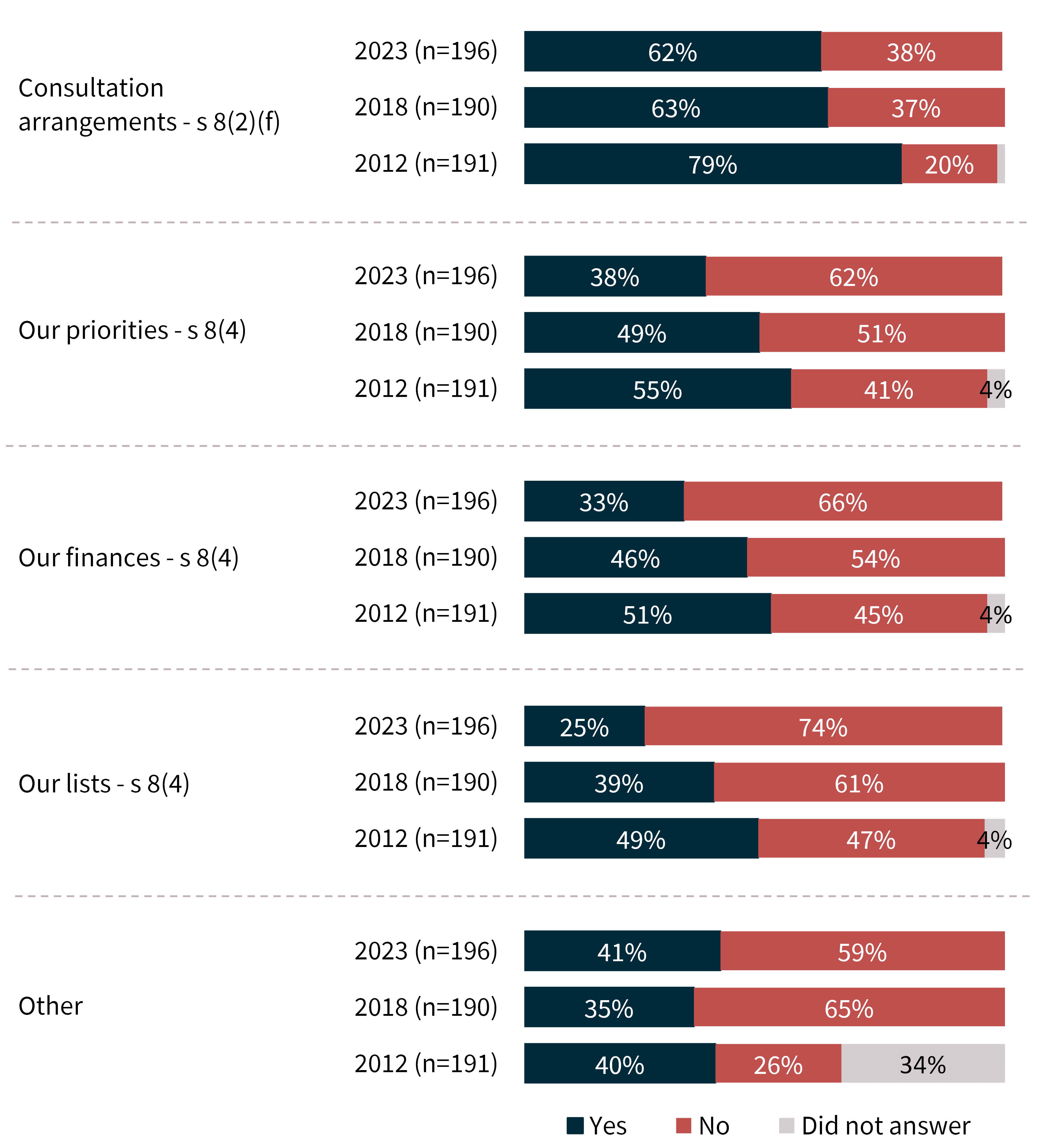
Documents are easily discoverable and understandable
73% of agencies have a search function that can access information published within an agency’s IPS entry
A guiding principle to help agencies meet their IPS obligations is that information published under the IPS should be easily discoverable and understandable.
Figure 34 shows there was wide variation in the proportion of agencies that provided access to a range of website features that may assist in this regard and the proportion of agencies that used these features has decreased since 2012 (with the exception of a search function that can access information published within an agency’s IPS entry). These results show:
- 73% of agencies reported they have a search function that can access information published within an agency’s IPS entry (up from 63% in 2018, but less than the 81% recorded in 2012)
- 54% of agencies indicated they have a mechanism in place to gather feedback from the community regarding whether IPS entries are easily discoverable and understandable (down slightly from 58% in 2018 and 66% in 2012)
- 14% of agencies indicated that the OAIC IPS Icon is visible on the homepage of their website – down from the 25% in 2018 and well below 59% in 2012
- 13% of agencies indicated they have an alert service that can notify subscribers of new publications under the IPS or other developments in relation to the IPS (compared with 23% in 2018 and 26% in 2012).
Base: All agencies
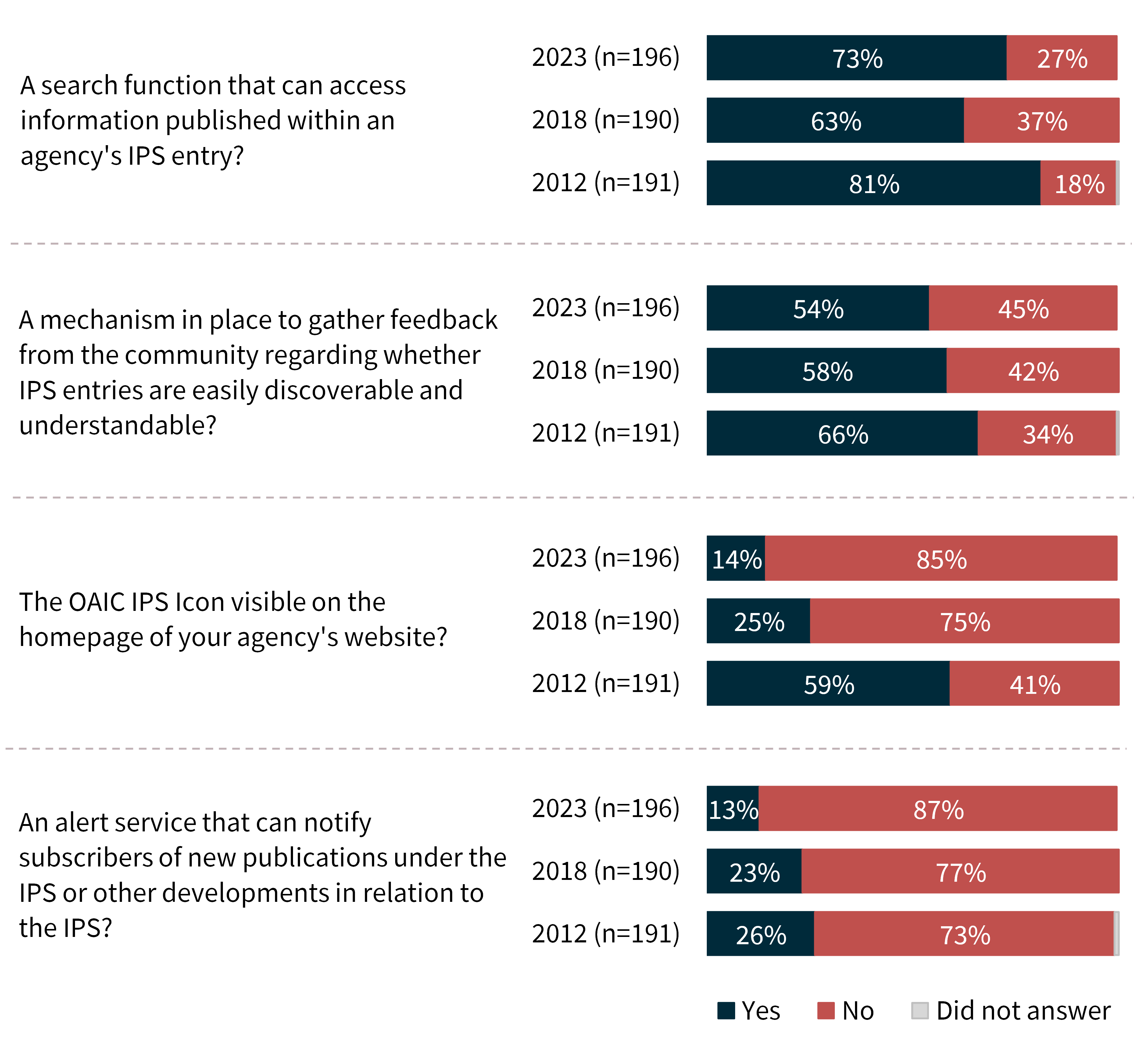
Of the 14% of agencies that display the OAIC IPS Icon on the homepage of their website, 79% indicated the icon linked to the Agency IPS or FOI information page, while 21% indicated it did not link to another webpage (see Figure 35).
Base: Agencies that have the OAIC IPS Icon visible on the homepage of your agency’s website
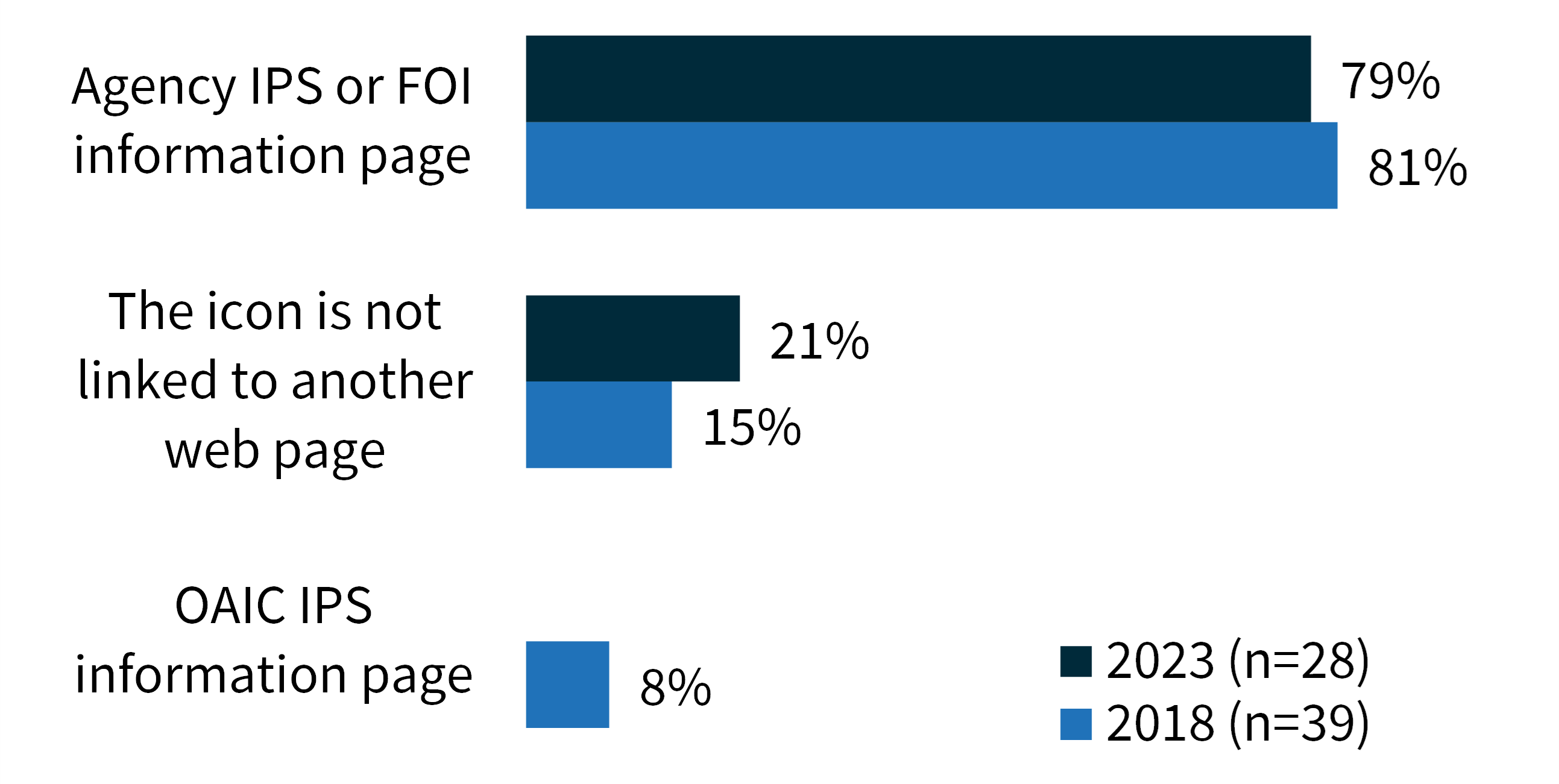
Documents are easily accessible and machine readable
82% of agencies have published all or most documents under the IPS in a format (or multiple formats) that conform to WCAG 2.0 requirements
The FOI Guidelines state that accessibility of published information by all members of the community is an important principle underlying the IPS. Web Content Accessibility Guidelines (WCAG) cover a wide range of recommendations for making web content more accessible.
Figure 36 shows that in 2018, agencies were more likely to have published documents under the IPS in a format (or multiple formats) which conform to WCAG 2.0 requirements[36]. More specifically:
- 21% of agencies indicated that all documents they have published under the IPS are in a format (or multiple formats) which conform to WCAG 2.0 requirements, down from 28% recorded in 2018, but more than the 20% in 2012
- a further 61% of agencies indicated that most of their documents comply (up from 41% in 2018 and 30% in 2012)
- 14% of agencies indicated that some documents comply (down from 21% in 2018 and 44% in 2012)
- 4% of agencies indicated that none of their documents comply (down from 11% in 2018, but consistent with the 5% recorded in 2012).
Base: All agencies
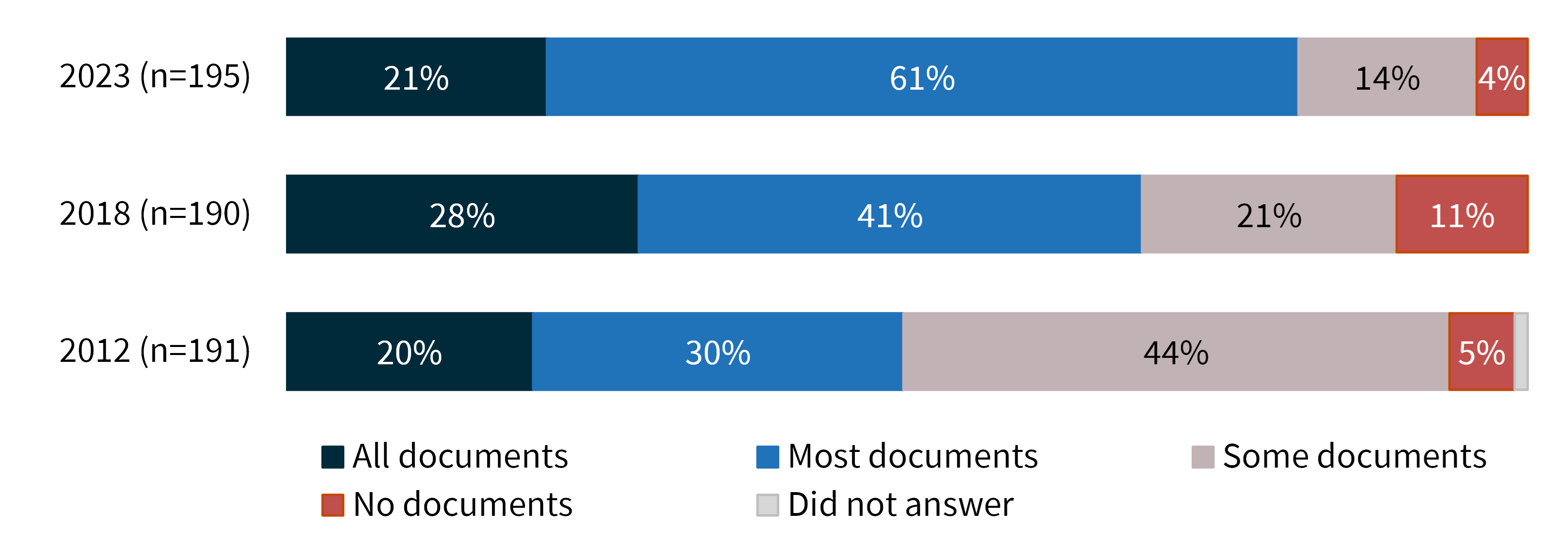
4.6 IPS risk mitigation index
The survey found that agencies assessed their compliance with the IPS moderately overall, with several areas showing considerable scope for improvement.
Figure 37 presents the results of an overall ‘risk mitigation index’ that summarises agencies’ responses across 5 key aspects of IPS compliance measured in the survey. This figure shows that agencies recorded an overall risk mitigation level of 55.9[37] in 2023. This index level is consistent with agencies (on average) indicating that they comply with just over half of the IPS requirements measured in the survey.
This figure also shows the IPS risk mitigation index has remained stable since 2018 (55.2) but declined since 2012 from an index level of 75.7.
Base: All agencies. Higher index levels reflect better mitigation against the various forms of risk
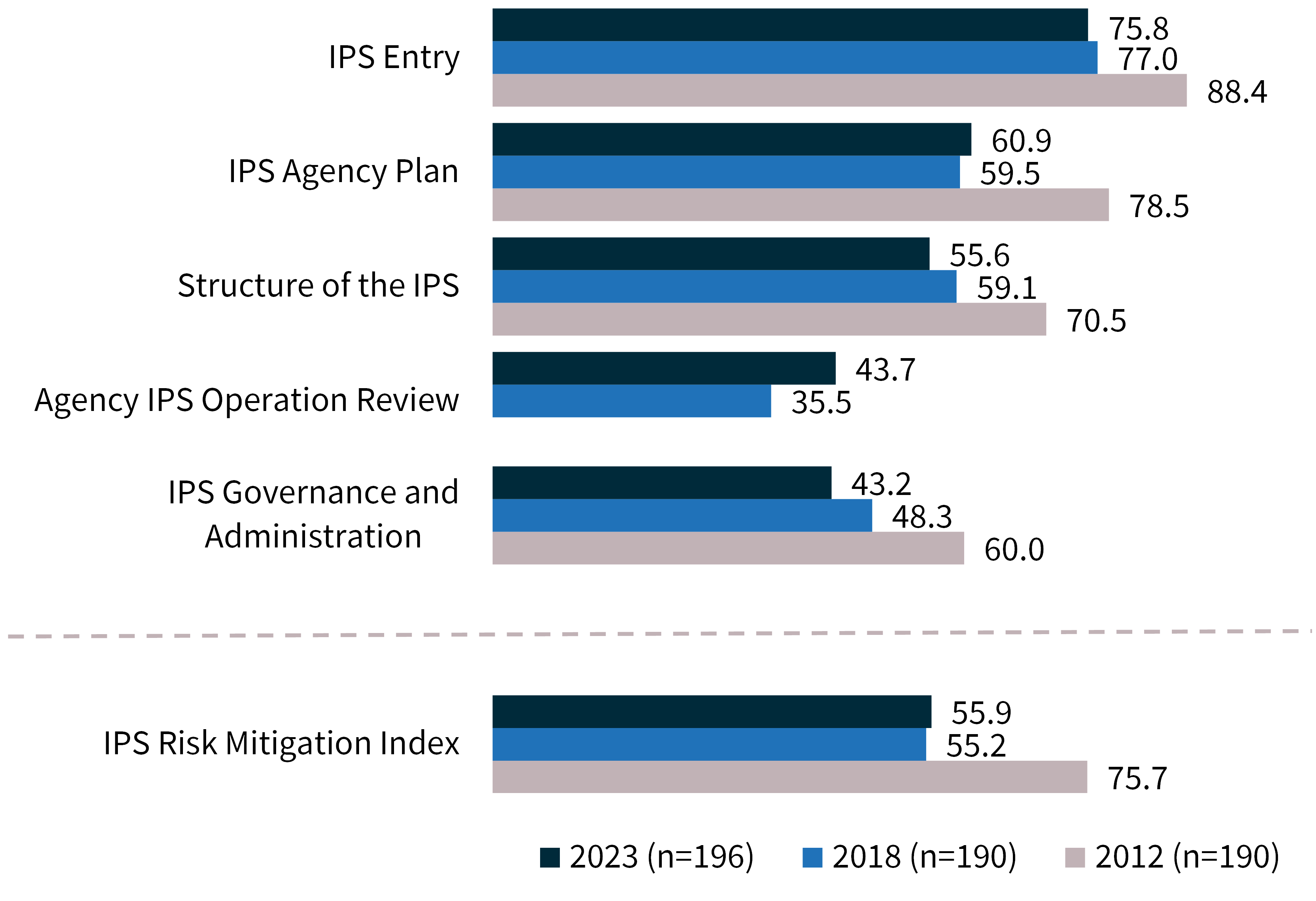
The risk mitigation index also shows that the agencies’ ratings of their compliance with the criteria varied considerably but were generally in line with 2018 but below 2012. More specifically:
- the most favourable assessments were recorded for agencies’ IPS Entry, which recorded a high level of 75.8 index points (ip), in line with 77.0ip recorded in 2018 but below 88.4ip recorded in 2012
- more moderate rates of compliance were recorded for IPS Agency Plan (60.9ip, in line with 59.5ip in 2018, but lower than the 78.5ip in 2012) and Structure of the IPS (55.6ip, slightly lower than 59.1ip in 2018 and well below 70.5ip in 2012)
- the lowest rates of compliance were recorded for Agency IPS Operation Review (43.7ip, higher than the 35.5ip in 2018) and IPS Governance and Administration (43.2ip, below 48.3ip in 2018 and 60.0ip in 2012).
5 Management and publication of public sector information
5.1 Open access to information
Open access to information
29% of agencies have adopted a strategy for increasing open access to public sector information
Figure 38 shows that 29% of agencies surveyed in 2023 indicated they have adopted a strategy for increasing open access to public sector information held by their agency, in addition to the information required to be published in the IPS and Disclosure Log – down from 35% recorded in 2018, but higher than the 27% in 2012.
The proportion of agencies indicating that this strategy is under development in 2023 declined from both 2018 (26%) and 2012 (48%), to 17%. While the proportion of agencies that indicated they have not adopted a strategy has increased significantly (from 25% in 2012 and 39% in 2018 to 54%).
Base: All agencies
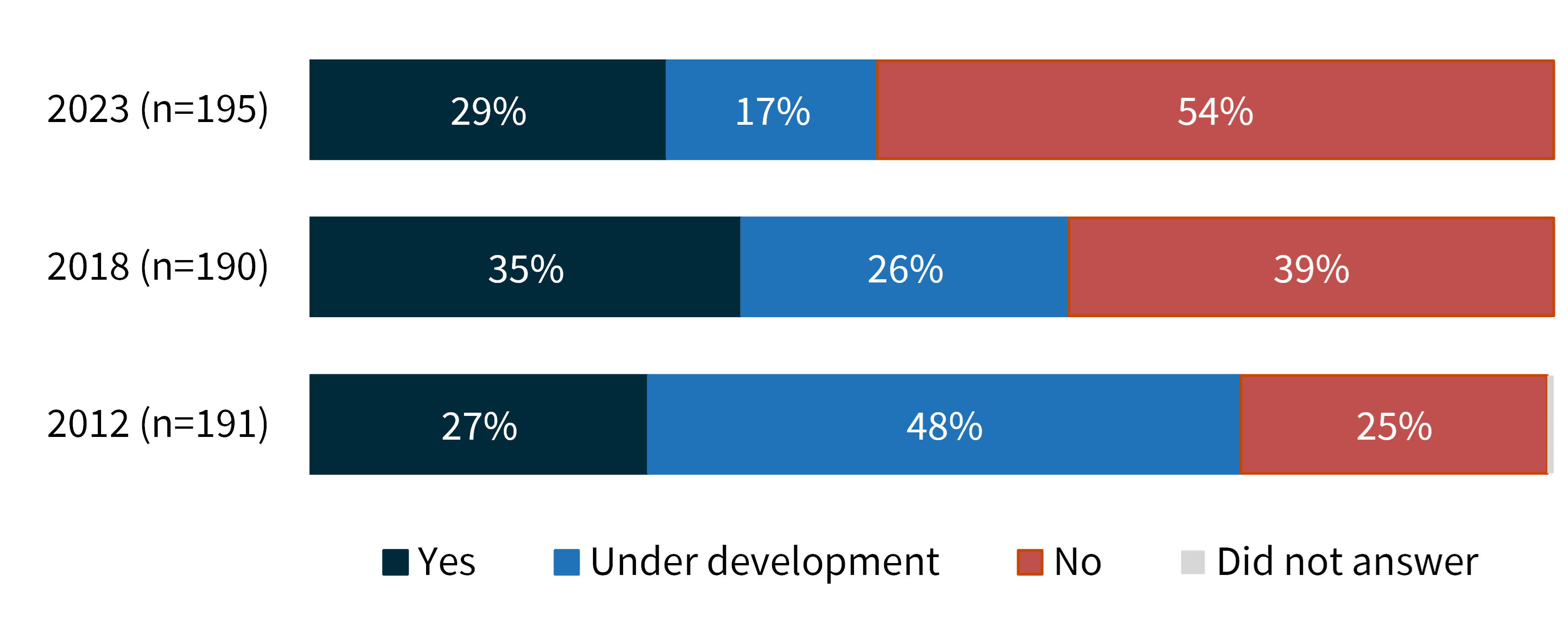
Seventy-three per cent of agencies used social media to publish or promote access to public sector information. Fifty-six per cent of agencies used stakeholder networks to share this information, and half of agencies used newsletters. Sixteen per cent of agencies did not publish or promote access to public sector information (Figure 39).
Base: All agencies
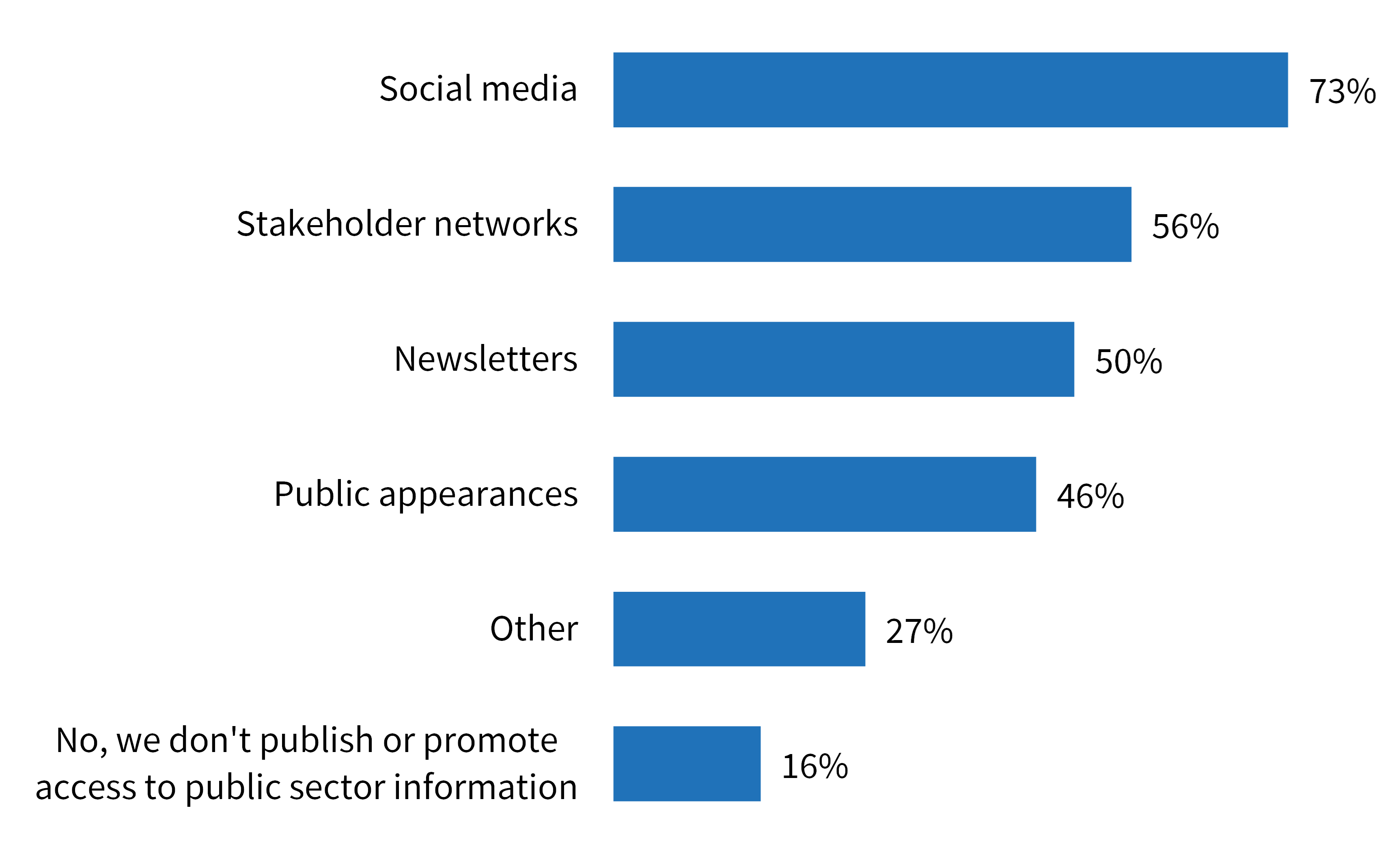
Agencies were most likely to use LinkedIn (65%), followed by X (formerly known as Twitter) (55%), Facebook (52%) and YouTube (48%) to publish or promote access to public sector information.
Base: All agencies
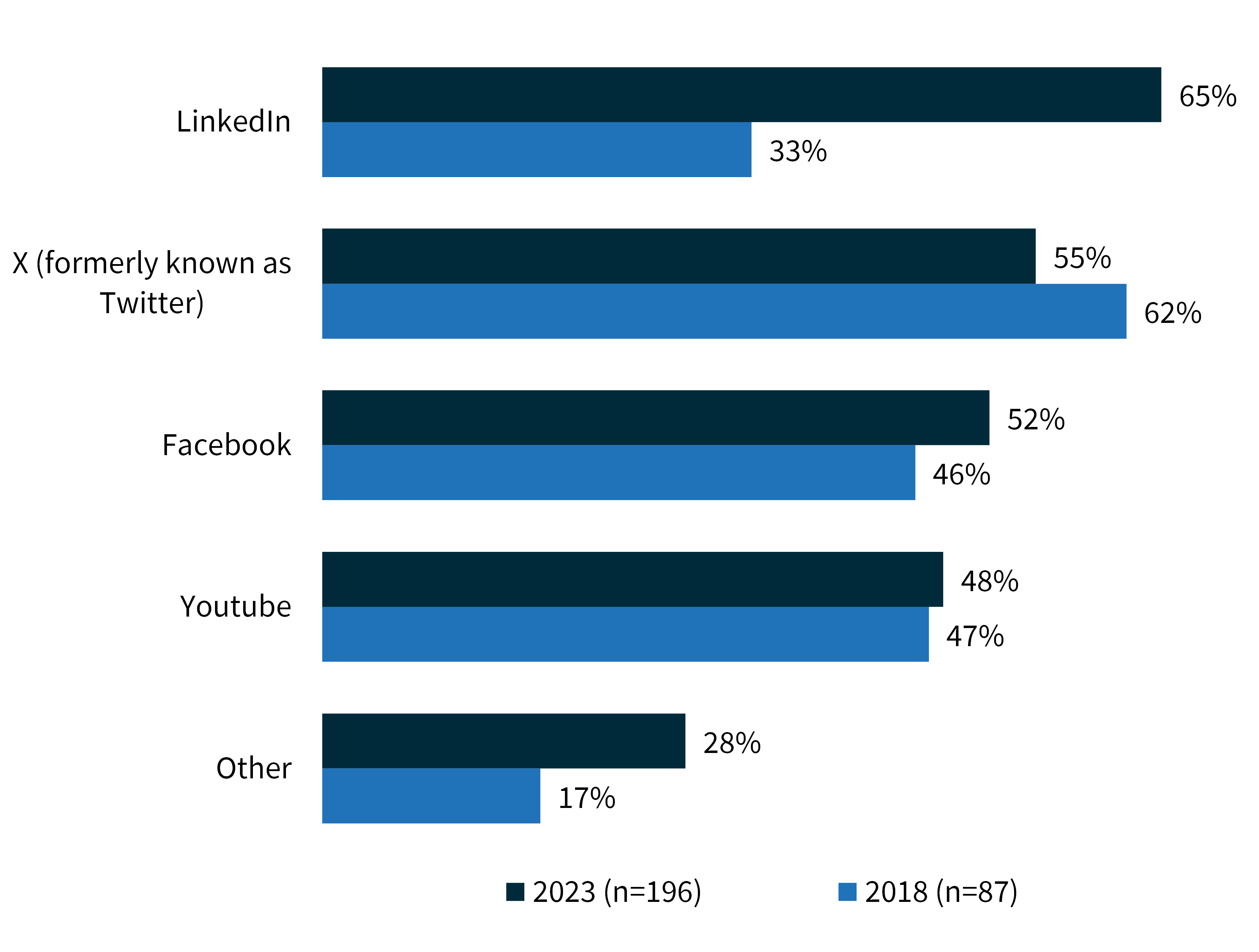
5.2 Discoverability
In 2023, 65% of agencies indicated that most or all of the public sector information they published was in an open and standards-based format; higher than the proportions recorded in 2018 (60%) and 2012 (37%). More specifically, Figure 41 shows:
- 28% of agencies publish all public sector information in an open and standards-based format (up from 24% in 2018 and 14% in 2012)
- 36% publish most of the information in these formats, consistent with 2018 (36%) and higher than 2012 (23%)
- 9% publish some of the information in these formats, consistent with the proportion recorded in 2018 (8%) and well below the proportion in 2012 (39%)
- 25% of agencies indicated they were not sure or it was not applicable that public sector information is published in an open and standards-based format, similar to 2018 (29%) and 2012 (21%).
Base: All agencies
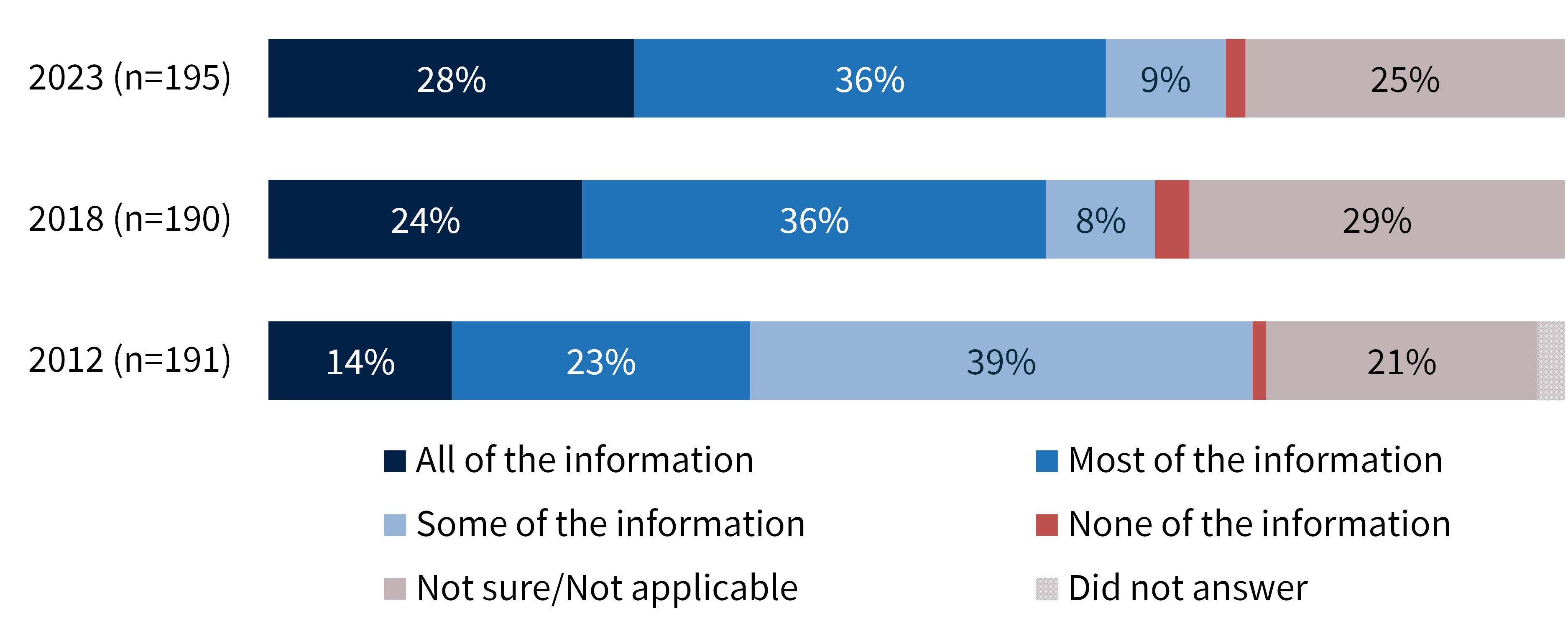
In 2023, 53% of agencies indicated they apply metadata to public sector information they publish on the internet (up from 46% recorded in 2018 and 49% in 2012) and were most likely to use ‘Other’ metadata standards (87%) – mainly Australian Government Locator Service (AGLS), followed by Dublin Core Metadata Initiative (DCMI). The proportion that indicated they did not apply metadata in 2023 (32%) decreased slightly from 2018 (34%) and more significantly from 2012 (42%) – see Figure 42.
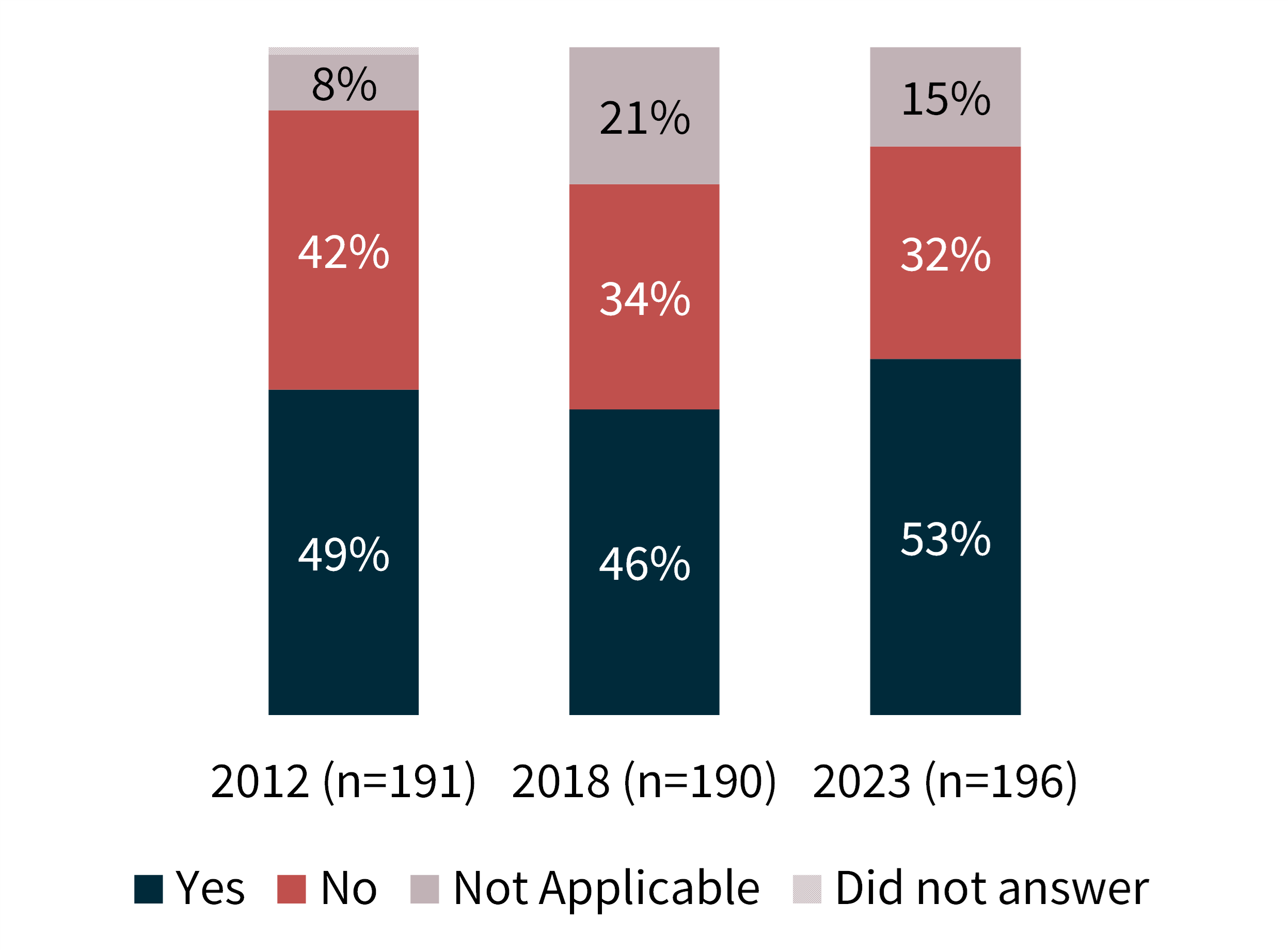
Further analysis of discoverability by specific agency characteristics
Aspects of discoverability generally varied according to agency size rather than the number FOI requests:
- extra large agencies (40%) were most likely to maintain an IPS information register compared to agencies of other sizes (15 to 24%) and review their register more frequently (50% do so at least every 6 months) compared to relatively smaller sized agencies (0 to 40%)
- extra small (30%) and micro agencies (44%) were least likely to routinely apply metadata to the public sector information they publish on the internet compared to larger agencies (51 to 72%)
5.3 Challenges to publishing public sector information
86% of agencies identified aspects of open access to information as the most significant challenge faced when publishing public sector information
The 2023 survey asked agencies to identify the 6 most significant challenges they face when publishing public sector information in addition to the information required to be published in the IPS and Disclosure Log. Figure 43 and Table 3 show:
- the majority (86%) of agencies identified aspects of open access to information in their top 4 challenges (up from the 77% in 2018 and 79% in 2012). These were mainly in relation to:
- ensuring compliance with privacy and secrecy requirements when publishing public sector information (35%)
- obtaining sufficient budgetary resources to enable open access to public sector information (31%) – this is consistent with the high proportion of agencies indicating they do not have a formal IPS governance structure (78%) and the associated reason of a lack of resources
- identifying information, in addition to the information required to be published in the IPS and Disclosure Log, that can be published (31%)
- 65% identified aspects of robust information asset management being their top 4 challenges (up from 48% in 2018 and 37% in 2012). These were most commonly in relation to:
- establishment and maintenance of an information asset register (36%)
- protecting information against inappropriate or unauthorised use, access or disclosure (23%)
- providing up-to-date staff training in information management (22%)
- agencies were least likely to identify aspects of appropriate charging for access (4% in 2018) and transparent enquiry and complaints process (5% in 2018) as part of their top 4 challenges.
Base: All agencies
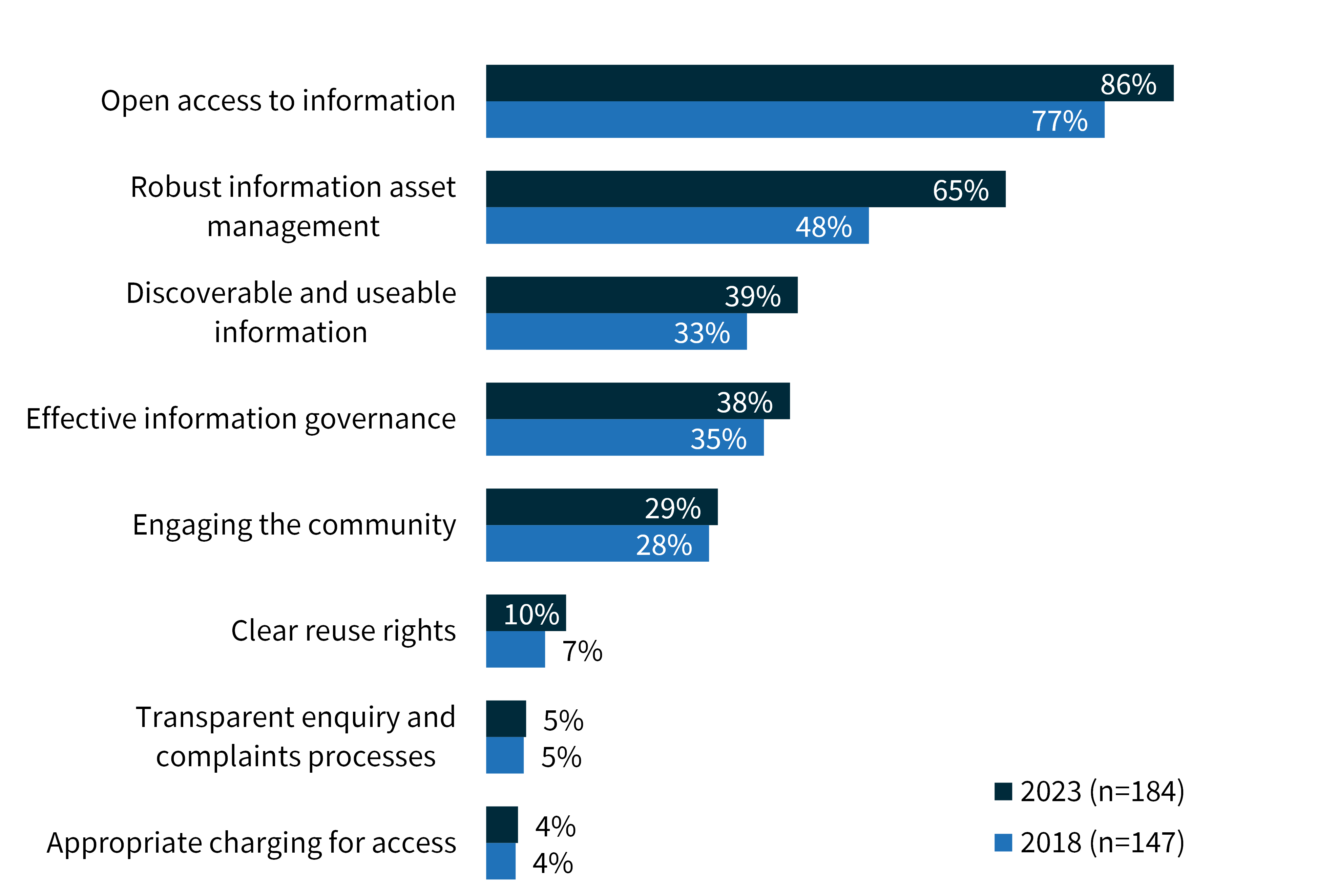
Challenge | % selected |
|---|---|
Open access to information | 86% |
Ensuring compliance with privacy and secrecy requirements when publishing public sector information | 35% |
Obtaining sufficient budgetary resources to enable open access to public sector information | 31% |
Identifying information, in addition to the information required to be published in the IPS and Disclosure Log that can be published | 31% |
Producing a plan or strategies for increasing open access to public sector information | 16% |
Transitioning to a culture of open access and proactive publication | 12% |
Robust information asset management | 65% |
Establishment and maintenance of an information asset register | 36% |
Protecting information against inappropriate or unauthorised use, access or disclosure | 23% |
Providing up–to–date staff training in information management | 22% |
Establishing clear procedures and lines of authority for decisions on information release and publication | 11% |
Effective information governance | 38% |
Instigating strategic planning on information resource management | 21% |
Establishing an appropriate focal point, officer, or centralised department that is responsible for furthering open access to public sector information | 19% |
Discoverable and useable information | 39% |
Agency costs (including staff time) associated with ensuring compliance with WCAG 2.0 | 14% |
Ensuring compliance with WCAG 2.0 | 11% |
Attaching high-quality metadata to information for discoverability | 7% |
Providing information in an open and standards–based format | 6% |
Indexing or cataloguing information for discoverability | 6% |
Publishing information in machine readable format | 5% |
Engaging the community | 29% |
Identifying re-users | 12% |
Establishing effective processes to consult the community regarding what information to publish | 8% |
Collaborating re-users | 6% |
Footnotes
[1] Section 3(3) FOI Act
[2] Paragraphs 13.143 to 13.146 of the FOI Guidelines.
[3] A report of the 2018 IPS Survey results is published on the OAIC website. A separate report on agency implementation of the Principles on open public sector information was published in February 2013 on the OAIC website.
[4] Section 9(1) of the FOI Act requires agencies to complete a review of the operation of the IPS within their agency, as appropriate from time to time and within 5 years of the commencement of the IPS (by 1 May 2016), in conjunction with the Information Commissioner. The Information Commissioner considered that the completion and submission of the 2023 IPS agency survey satisfied agencies’ requirement to complete a review of the operation of the IPS.
[5] Calculated from the last day of the extended fieldwork period (25 October 2023).
[6] Paragraph 13.165 of the FOI Guidelines notes the 5 key elements of IPS compliance: Agency Plan; Governance and administration; IPS document holdings; Structure of the IPS, and Agency compliance review.
[7] References to ‘information architecture’ changed to ‘Structure of the IPS’ – refer updated FOI Guidelines - August 2023.
[8] Refer 13.152-153 of the FOI Guidelines.
[9] The IPS review survey is based on reviewing compliance with WCAG 2.0; however, it is noted that since the surveys commenced the level required for Australian Government agencies has been increased to WCAG 2.1 AA.
[10] A report of the 2012 IPS Survey results is published on the OAIC website.
[11] Open public sector information: from principles to practice, OAIC, February 2013.
[12] Refer 13.165 of Part 13 of the FOI Guidelines.
[13] Section 9 of the FOI Act requires agencies to complete a review of the operation of the IPS within their agency, within 5 years of the commencement of the IPS. The review is to be done in conjunction with the OAIC.
[14] Ministers are not required to comply with the IPS so were excluded from the IPS agency survey.
[15] This interpretation is because most of the measures in the index either attract a score of 2 (for compliance) or 0 (for non-compliance), therefore if an agency complies with 3 of the 6 measures they receive a risk mitigation index score of 50 – representing compliance with 50% of the assessed measures. While Appendix G provides more detail about the calculation of the risk mitigation index and shows that a small number of questions feed into the index in a different way, this represents an approximate interpretation of the risk mitigation level.
[16]The number of FOI requests in 2012 has been re-calculated using a method consistent with the 2018 and 2023 data. Agencies whose number of FOI requests have been duplicated from a parent agency’s response has been removed and calculated as part of the ‘not answered’ category.
[17] ‘Agency operation review’ was referred to as ‘Criterion Five’ in 2012 as set out in the FOI Guidelines to assess IPS compliance. This criterion could not be measured in 2012 due to the requirement for each agency to complete a review of its IPS Compliance by 1 May 2016 under the FOI Act.
[18]All Australian Government agencies subject to the FOI Act were in scope for the IPS agency survey.
[19] Section 9(1) of the FOI Act requires agencies to complete a review of the operation of the IPS within their agency, as appropriate from time to time and within 5 years of the commencement of the IPS (by 1 May 2016), in conjunction with the Information Commissioner. The Information Commissioner considered that the completion and submission of the 2018 IPS agency survey satisfied agencies’ requirement to complete a review of the operation of the IPS.
[20]In 2018 the question was worded, ‘How many complaints specifically related to the IPS has your agency received since 1 July 2017?’ In 2023 the question was worded, ‘How many complaints about your agency’s IPS did your agency receive in 2022–23?’
[21]Question wording difference – 2012: ‘Does your agency have a representative who attends the ICON (Information Contact Officer Network) forum run quarterly by the OAIC?’ in 2018 it was: ‘Does your agency have an Information Contact Officer who participates in ICON?’ and in 2023: Does your agency have an Officer(s) who participate in ICON?
[22] ‘Agency IPS Plan’ was referred to as ‘Criterion One’ in 2012 as set out in the FOI Guidelines to assess IPS compliance.
[23] Question wording difference – 2012: ‘Has your agency prepared and published an Agency IPS Plan?’, and in 2018 it was: ‘Has your agency published an Agency IPS Plan?’, and in 2023 it was: ‘Does your agency have a published Agency IPS Plan on its website?’
[24] Question wording difference – 2012: ‘If you have a timetable, how often is a review of the Agency IPS Plan undertaken?’ and 2018: ‘If you have a timetable, how often is a formal review of the Agency IPS Plan scheduled to be undertaken?’
[25] The response option ‘On a regular basis but less often than every 12 months’ was provided in 2023 but not 2018 or 2012.
[26] ‘IPS Governance and Administration’ was referred to as ‘Criterion Two’ in 2012 as set out in the FOI Guidelines to assess IPS compliance.
[27] Wording difference – in 2018 the question was: ‘Has your agency appointed a senior executive officer with responsibility for leading the agency’s work on IPS compliance?’ and in 2023 the question was: ‘Does your agency have a senior executive officer with responsibility for leading the agency’s work on IPS compliance?’
[28] Question wording difference – 2012: ‘Has responsibility for staff training and awareness of IPS obligations within the agency been assigned?’ and in 2018 and 2023 it was: ‘Has responsibility for the management or coordination of staff training and awareness of IPS obligations within the agency been assigned?’
[29] ‘IPS Entry’ was referred to as ‘Criterion Three’ in 2012 as set out in the FOI Guidelines to assess IPS compliance.
[30] Question wording difference – 2012: ‘Has your agency published on its website details of: Information in documents to which the agency routinely gives access in response to requests under Part III of the FOI Act (with exceptions)?’ and 2018: ‘Information in documents to which the agency routinely gives access in response to requests under Part III of the FOI Act – s 8(2)(g)?’
[31] In 2012, an IPS Information register was referred to as an ‘information asset register’.
[32] In 2012, this was referred to as an ‘information asset register’.
[33] Freedom of Information (Charges) Regulations 2019
[34] Structure of the IPS (formerly ‘IPS Information Architecture’) was referred to as ‘Criterion Four’ in 2012 as set out in the FOI Guidelines to assess IPS compliance.
[35] Part 13 of the FOI Guidelines, Version 1.1, October 2011.
[36] The IPS review survey is based on reviewing compliance with WCAG 2.0; however, it is noted that since the surveys commenced the level required for Australian Government agencies has been increased to WCAG 2.1 AA.
[37] The risk mitigation index is derived based on the mean rating of agencies for relevant questions included under the 5 IPS criterion outlined in Figure 37. Higher index levels are more positive and represent greater levels of compliance with IPS requirements and therefore a higher level of mitigation of the risks associated with a lack of compliance. Page 15 provides more detail about how the risk mitigation indices are calculated.
[38] Wording difference – in 2018 the question was: ‘Has your agency adopted a strategy for increasing open access to public sector information held by your agency, in addition to the information required to be published in the IPS and Disclosure Log?’. In 2023 it says: ‘Does your agency have a strategy for increasing open access to public sector information held by your agency, in addition to the information required to be published in the IPS and Disclosure Log?’
[39] In 2018 ‘Instagram’ was a response option to the question ‘Which of the following social media sites does your agency use to publish or promote access to public sector information?’ Responses selecting this option have been merged into the ‘Other’ category.
[40] Wording difference for responses – in 2012 and 2018, agencies could select the response option ‘Not sure/Not applicable’ but in 2023 it was ‘Not sure’.
Appendices
(Published online only)
Appendix B: Summary survey results table
Appendix C: Overall frequency results
Appendix D: Survey results by agency size
Appendix E: Survey results by number of FOI requests June 2024 Information Publication Scheme
Appendix F: List of agencies whose responses were covered by other agencies (Note: This appendix has not been published because the list identifies individual agencies)
Appendix G: Composition of Risk Mitigation
Appendix H: Verbatim free text comments (Note: This appendix has not been published because the comments identify individual agencies)
Downloads
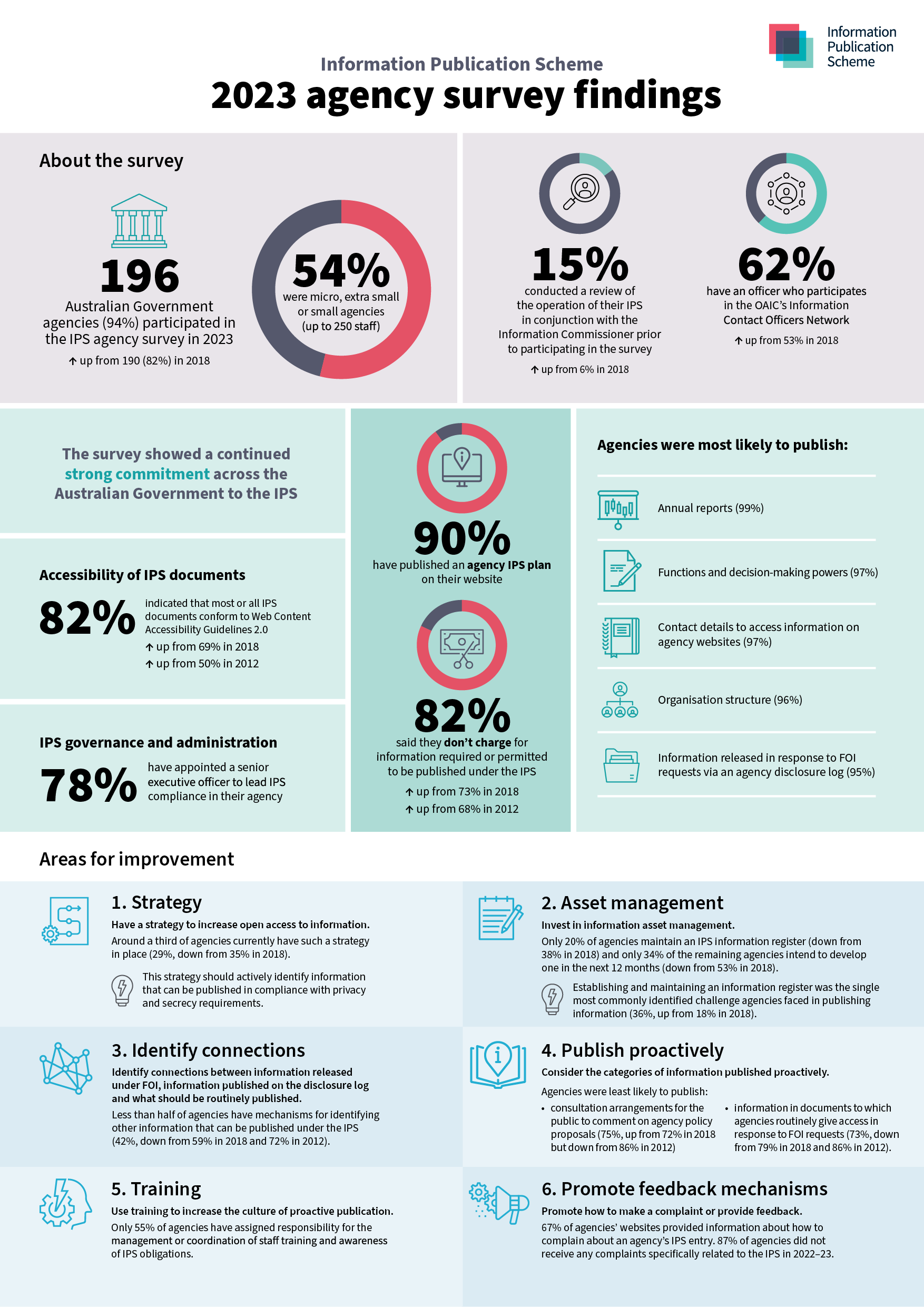
Download the IPS Agency survey findings infographic
